Classicists and supporters gathered en masse on Tuesday, February 20, to celebrate the work of Peter van Minnen, John Miller Burnam Professor of Classics and world-renowned papyrologist.
A Festschrift in van Minnen’s honor featuring an impressive 37 authors(!) and 62 congratulatory signatories, Unending Variety: Papyrological Texts and Studies in Honour of Peter van Minnen (Papyrologica Lugduno-Batava vol. 42, Leiden; Boston: Brill), was presented by Andrew Connor, Monash University, Melbourne, one of van Minnen’s former students and one of the editors. Two of the other editors, Cisca Hoogendijk in Leiden, and Jitse Dijkstra, University of Ottawa and currently on a dig in Egypt, gave a talk and a congratulatory presentation respectively which both connected to and highlighted van Minnen’s groundbreaking research.
The head of the Classics Department, Professor Daniel Markovich, explained that papyrology is a relatively recently distinct field although the papyri themselves are not recent. They were the writing material of ancient Egypt, Greece, and Rome at least since ca. 3,000 BCE to ca. 400-900 CE. Initially, papyrology was subsumed under the field of palaeography (the study of old writing) and a suggested name for the new field, Markovich explained, was papyrography. Professor Markovich further related his first meeting with Professor van Minnen when Markovich was a graduate student. Little did he then know that the two would end up as professors and colleagues at the same institution years later. Markovich recounted the time when van Minnen was head of the UC Classics Department (2010-2015) and how efficient an administrator he was, and remembered, amusingly, how van Minnen was always running, presumably to manage it all, a sentiment the current head now appreciates. Professor Markovich also discussed how in the twentieth century thanks to the discovery of papyri the field of classics developed as a science, and how instrumental van Minnen has been in contextualizing papyrology within ancient history. He also reminded us that only 100,000 papyri have been published to date whereas there are a million of them yet to be published and examined hence the title of one of van Minnen’s articles (“The Millennium of Papyrology, 2001-,” see the bibliography below). Professor Markovich also relayed congratulatory words from Jay Twomey, Associate Dean of Arts and Sciences, who was unable to attend the event.
Matthijs Wibier, Assistant Professor of Classics, UC, and van Minnen’s Dutch compatriot, chaired a paper panel with contributors Dr. Andrew Connor whose talk was entitled “The burning door and the dung in the sanctuary: Anti-temple sentiment in the daily life of Roman Egypt,” recounting a daily life story on a papyrus in Berlin about priests discovering that the doors to their neighborhood Busiris temple were on fire, and Dr. Cisca Hoogendijk whose talk was entitled “What was written on the other side of the Concordance to the Sortes Astrampsychi” (an oracular fortune-telling guide), discussing various documents on the other side of the guide such as property registers and dowry agreements. Dr. Hoogendijk has collaborated with van Minnen since their time together at the University of Leiden where van Minnen was a research associate and taught courses on reading Greek documentary papyri.
Upon completing his dissertation, van Minnen held post-doctoral research positions at Leuven University and at the University of Michigan where he worked on texts to be included in the “Duke Databank of Documentary Papyri” (https://library.duke.edu/papyrus/texts/DDBDP-old.html), an essential research tool for papyrologists. Next, he went to Duke University where he cataloged their papyrus collection. He also held a post-doctoral research position at the University of Groningen. Peter van Minnen came to the University of Cincinnati in 2002. Since then he was also an Elizabeth A. Whitehead Distinguished Scholar at the American School of Classical Studies at Athens, 2008-2009, and hosted two American Society of Papyrology Summer Institutes, most recently in 2022. From 2006 to 2023 he was also Editor-in-Chief of the Bulletin of the American Society of Papyrologists.
Select publications of Peter van Minnen’s extensive publishing history were featured in an exhibition in the Classics Library, as were personal photos and objects of van Minnen with the family cat, as a doll, etc. Also included were a copy of Asterix apud Gothos (“Asterix among the Goths”) in Latin, and Het Mysterie van de Grote Piramide (“The Mystery of the Great Pyramid”) in De Aventuren van Blake en Mortimer (“The Adventures of Blake and Mortimer”) in Dutch, a comic series by Edgar P. Jacobs. Both are Belgian comic books from van Minnen’s youth. Also included in the exhibition was a papyrus plant on loan from John Wallrodt, Senior Research Associate, UC Classics. Gifts included a mug with the image of the famous Edwin Smith (medical) Papyrus, a facsimile on display (see below).
Some of van Minnen’s very extensive bibliography include much cited works such as: “Boorish and Bookish? Literature in Egyptian Villages in Fayum in the Graeco-Roman Period” (The Journal of Juristic Papyrology, vol. 28, 1998, pp. 99-184); “The Century of Papyrology (1892-1992)” (The Bulletin of the American Society of Papyrologists, vol. 30, no. 1/2, 1993, pp. 5–18) looking back at Theodor Mommsen’s prophetic utterance that “the nineteenth century had been the century of epigraphy, but that the twentieth century would be the century of papyrology.” In 1891 literary papyri began to be published which changed the previous rather lukewarm interest of philologists; for example, the Aristotelian Constitution of Athens on a papyrus in the British Library, a facsimile of which the Library owns, and the poems of Bacchylides on a papyrus also in the British Library, a facsimile of which can also be found in our Library. Van Minnen laments the lack of interest in documentary texts in spite of Mommsen’s belief that Altertumswissenschaft (the study of the ancient world as a whole) would win the day and not classicism focusing on the “hay days” of Greece and Rome and often minute specialized “esoteric” aspects; “The Millennium of Papyrology (2001)?” (Akten des 23. Internationalen Papyrologenkongresses: Wien, 22.-28. Juli 2001, Wien: Verlag der Österreichischen Akademie der Wissenschaften, 2007, pp. 703-714); “The Origin and Future of Papyrology: From Mommsen and Wilamowitz to the Present, from Altertumswissenschaft to Cultural Studies” (Proceedings of the 20th international congress of papyrologists: Copenhagen, 23-29 August, 1992. Ed. Bülow-Jacobsen, Adam. Copenhagen: Museum Tusculanum Press, 1994, pp. 35-41); “Dietary Hellenization or Ecological Transformation?: Beer, Wine and Oil in Later Roman Egypt” (Atti del XXII congresso internazionale di papirologia: Firenze, 23-29 agosto 1998. Ed. Andorlini, Isabella. Firenze: Istituto Papirologico G. Vitelli, 2001, pp. 1265-1280); “From Posidippus to Palladas: What Have Literary Papyri Done for Us?” (The Journal of Juristic Papyrology, vol. 43, 2013, pp. 243-261).
Also included in the exhibition are works on Cleopatra whose signature van Minnen discovered on a royal decree on a mummy cartonnage from Abusir el-Melek dating to February 33 BCE shortly before the confrontation with Octavian, discussing among other things expenses for the military. The royal ordinance, as identified by van Minnen, contains one word in Greek, γινέσθωι (“make it happen”) (“An Official Act of Cleopatra: (with a subscription in her own hand)”) (Ancient Society, vol. 30, 2000, pp. 29-34); and “Further Thoughts on the Cleopatra Papyrus” (Archiv für Papyrusforschung und Verwandte Gebiete, vol. 47, no. 1, 2001, pp. 74-80). Needless to say, the discovery was debated but most believe that the signature is indeed that of the last Egyptian pharaoh in her own hand. For a more extensive bibliography, see below.
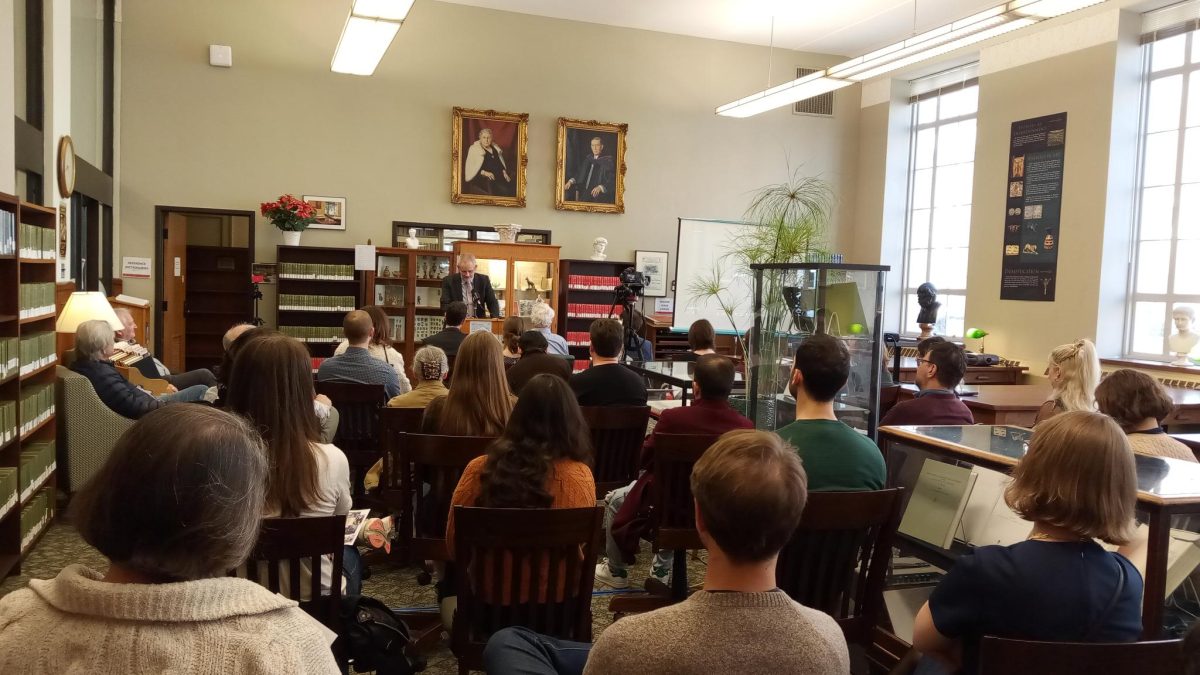
Also honoring van Minnen was Executive Vice President for Academic Affairs and Provost Valerio Ferme.
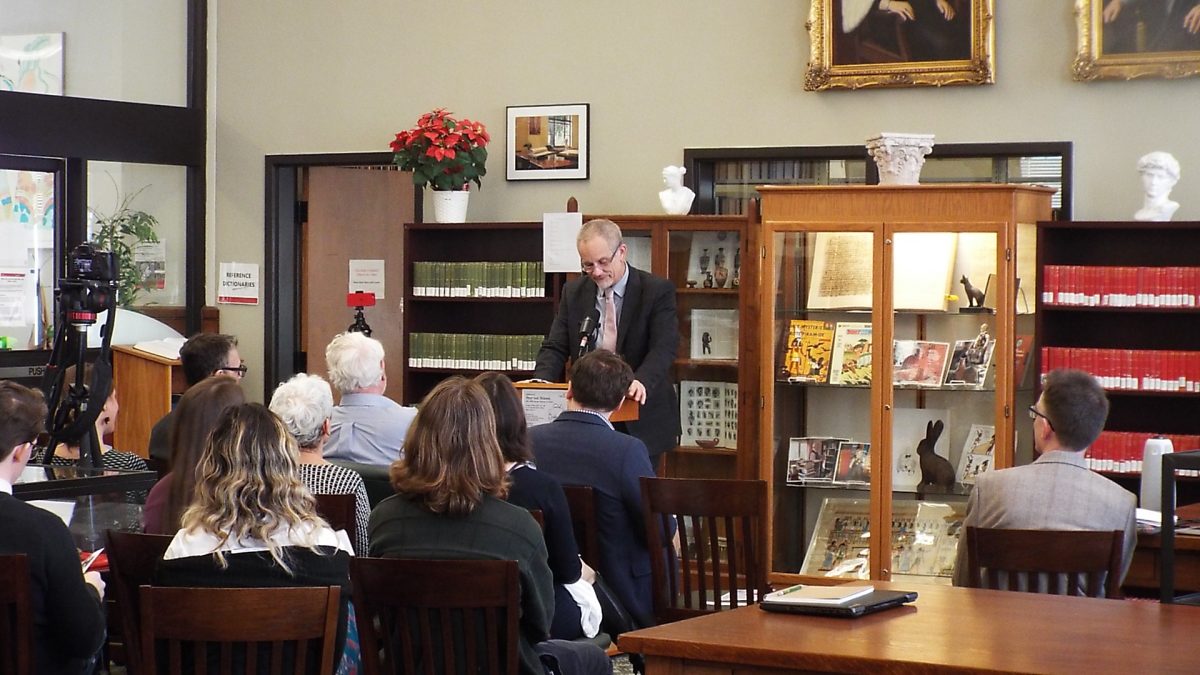
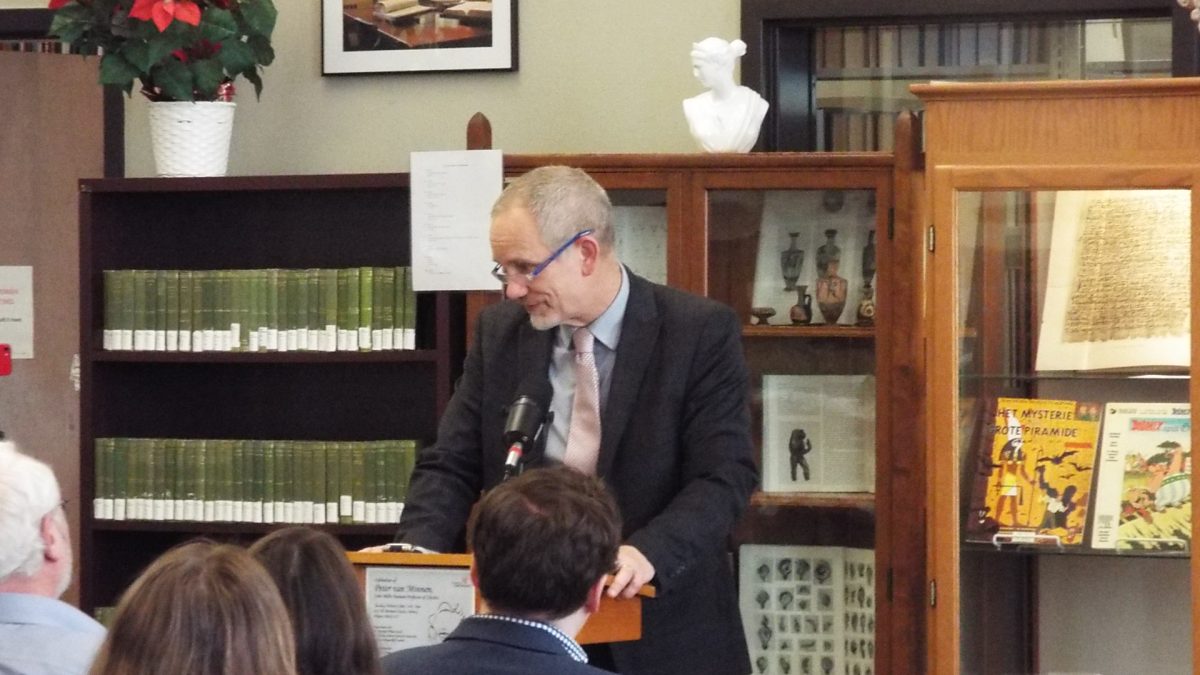
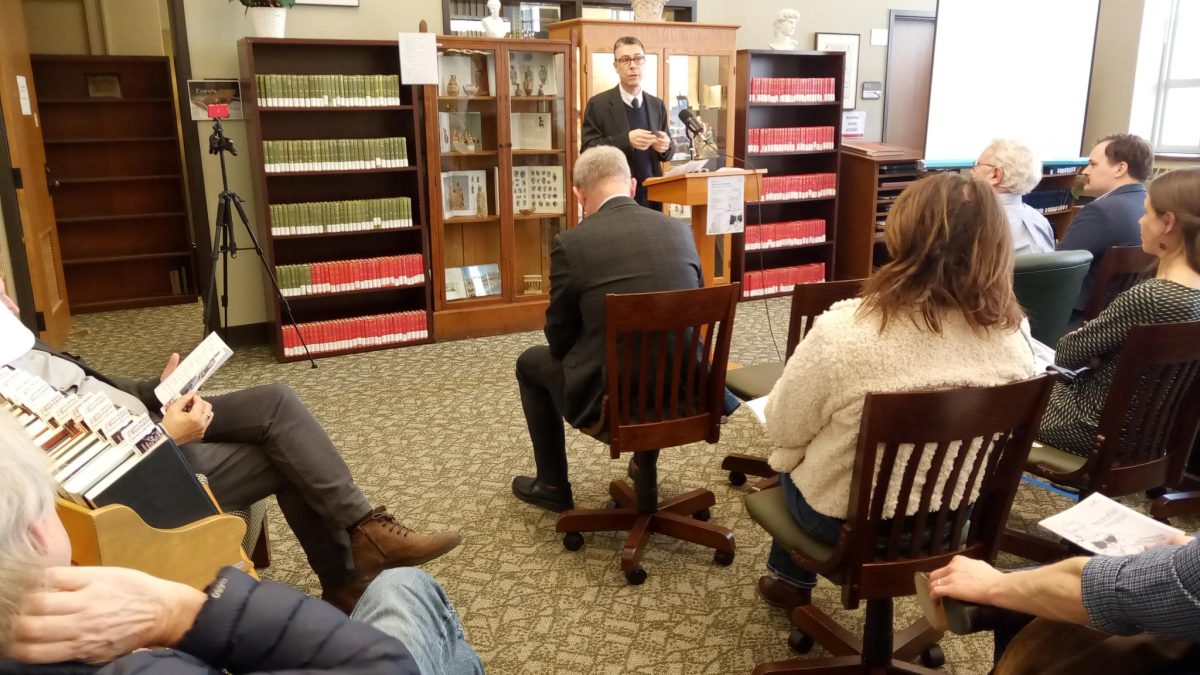
Professor Daniel Markovich, Head of the Classics Department, UC, recounted Peter van Minnen’s career and his many achievements.
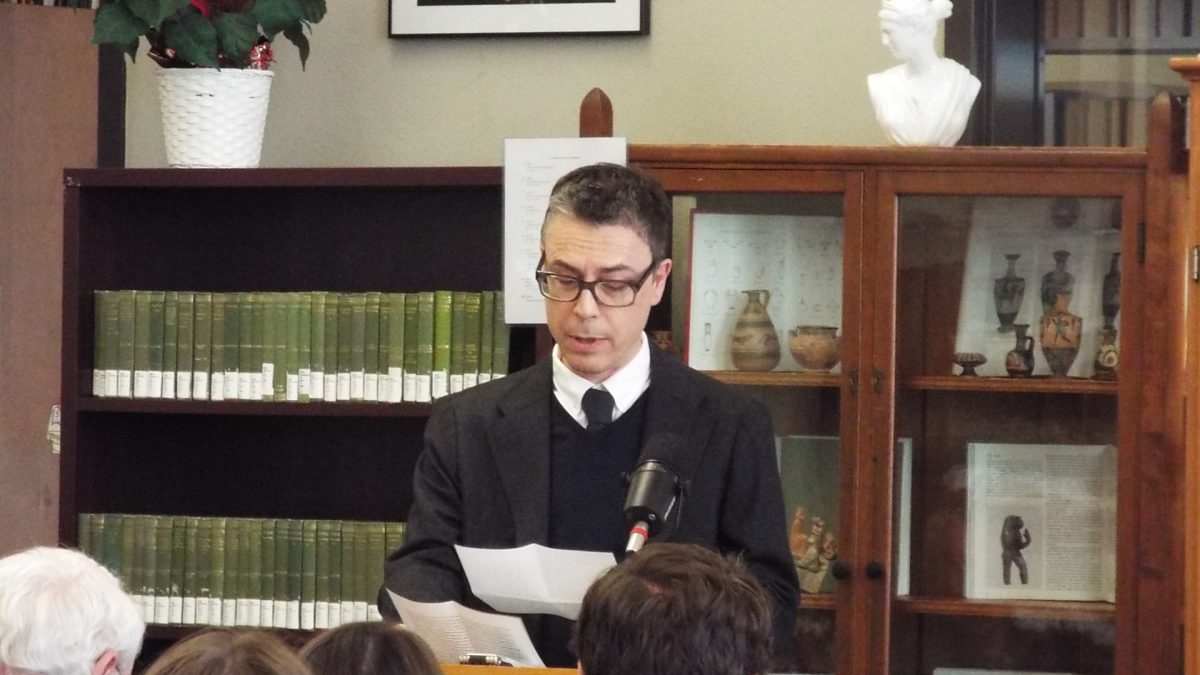

Assistant Professor Matthijs Wibier, UC, chaired a paper panel in van Minnen’s honor.
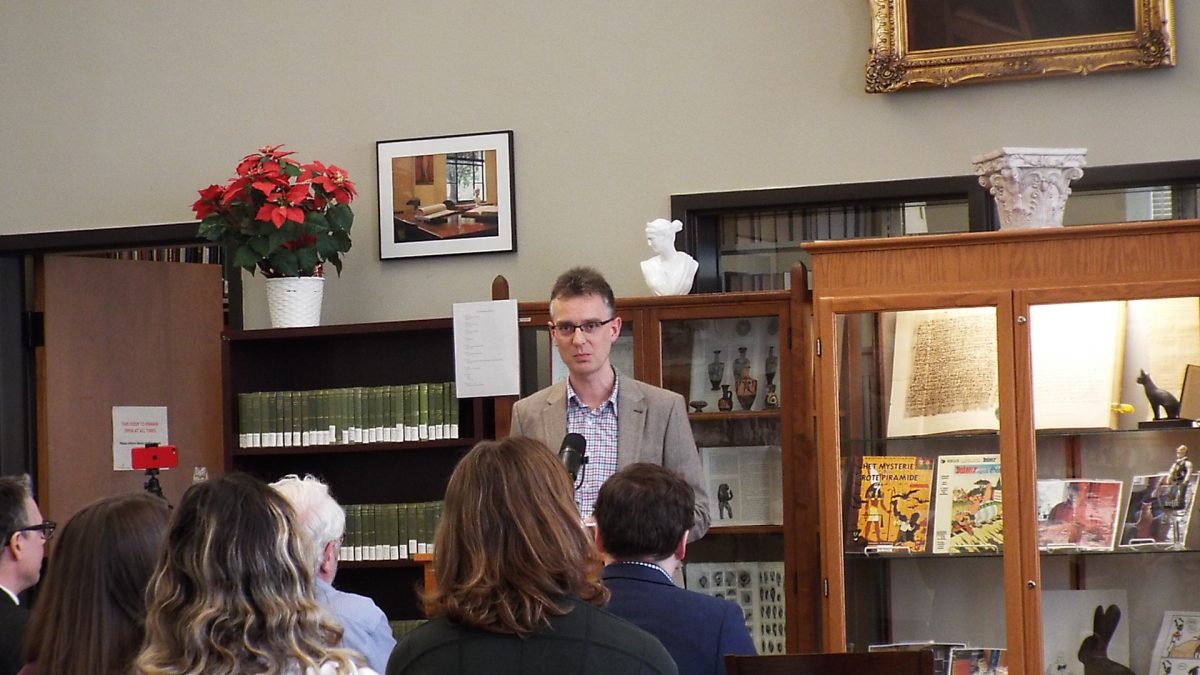
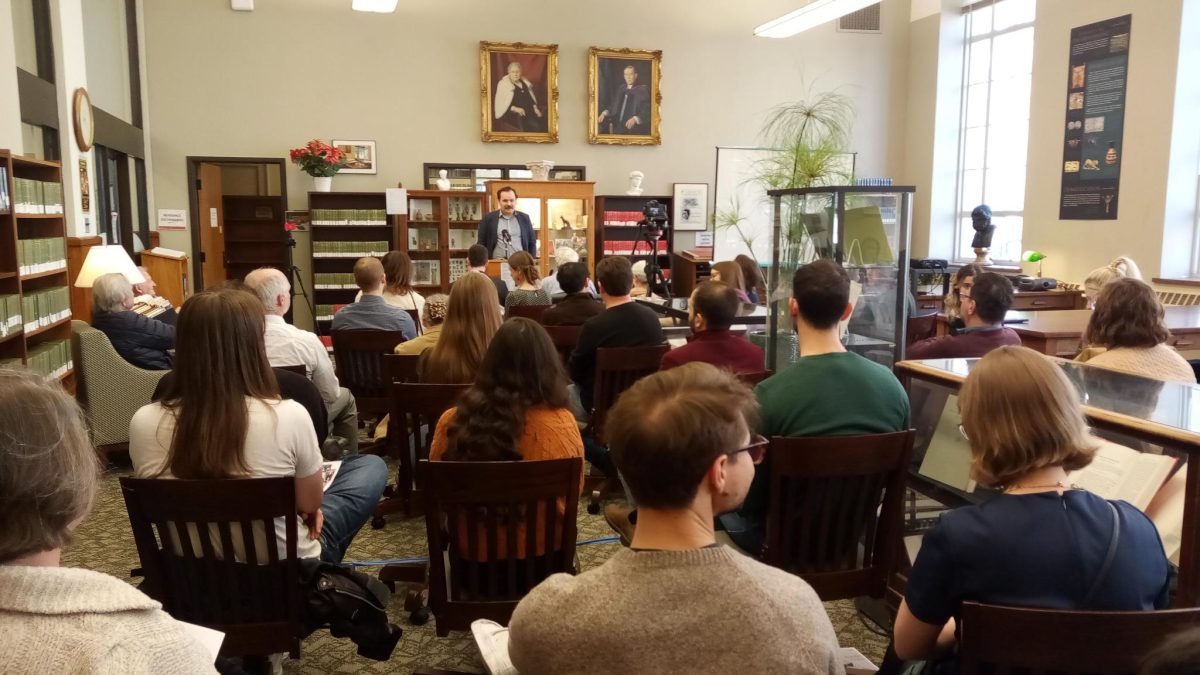
Dr. Andrew Connor, Monash University, was the principal organizer of the event, an editor of the Festschrift, and panelist.
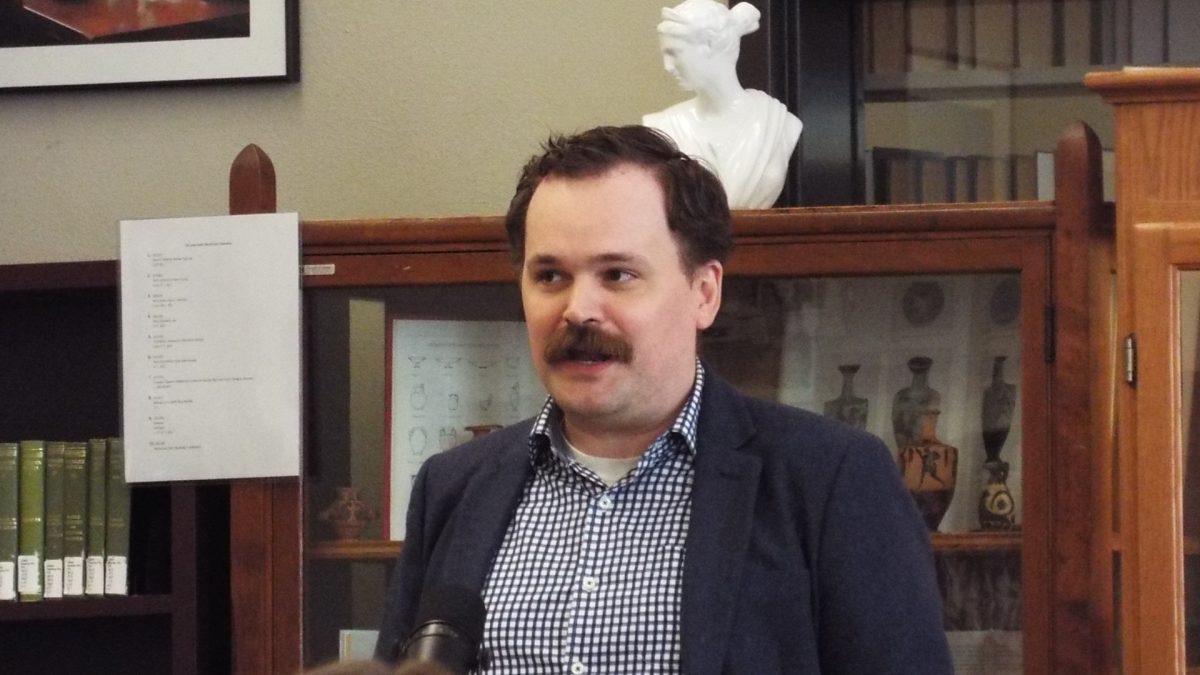
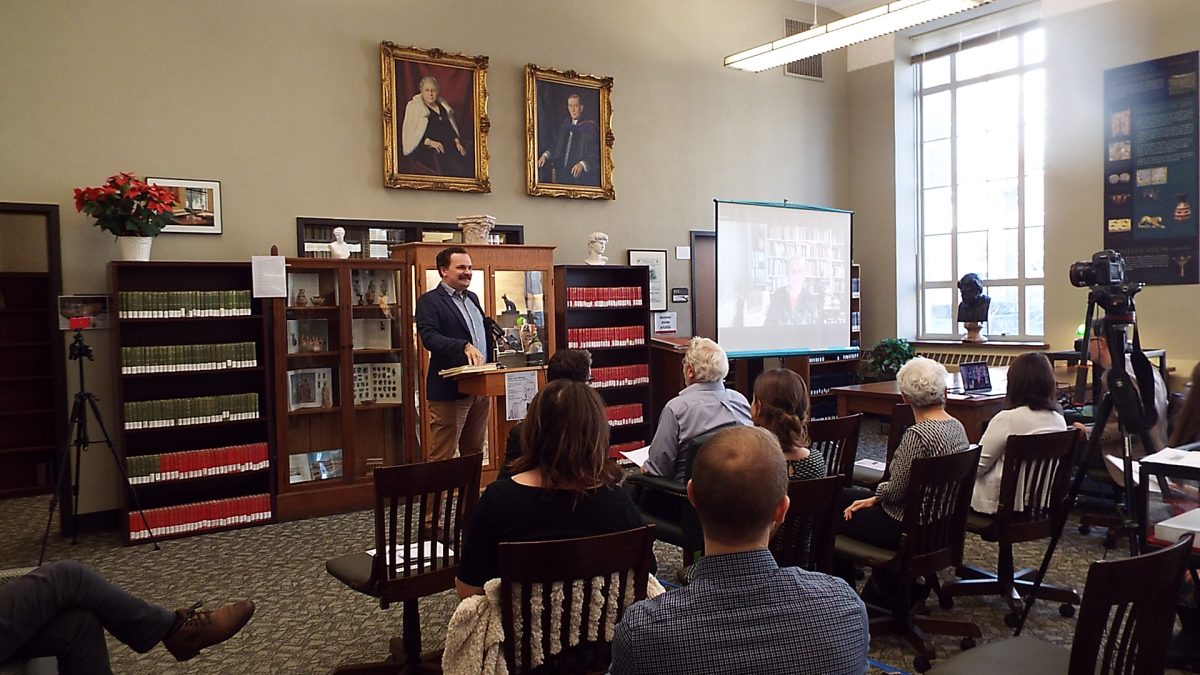
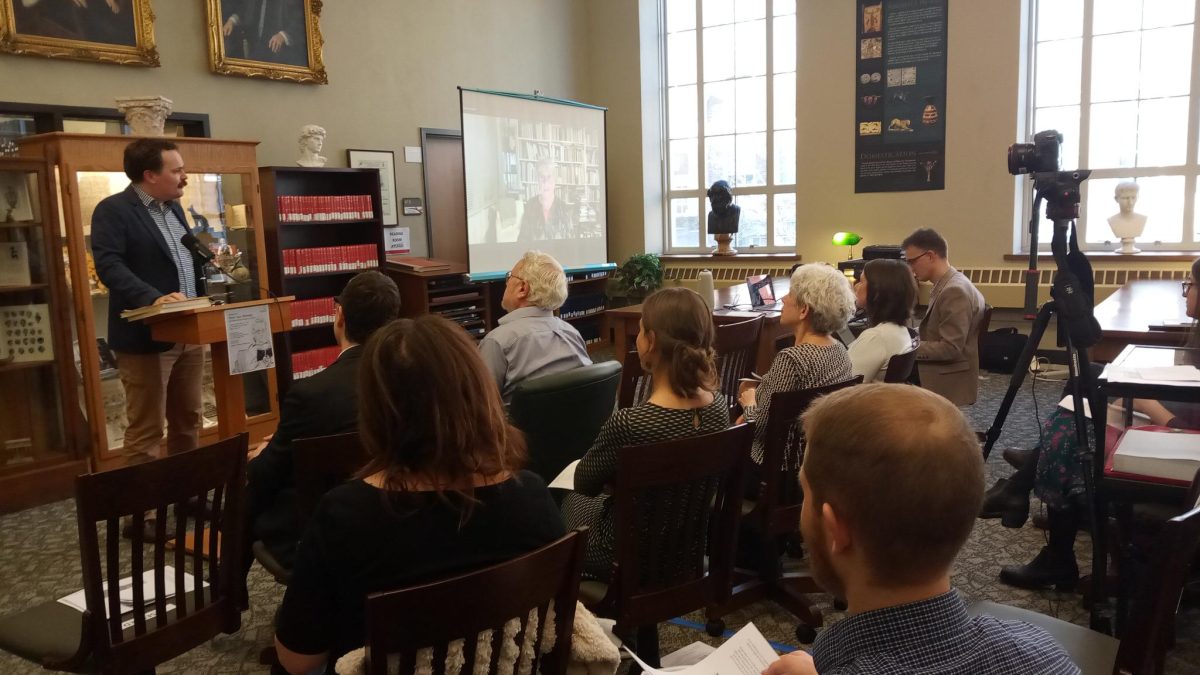
Dr. Cisca Hoogendijk via Zoom from Leiden, the Netherlands, was one of the panelists, and co-editor of the Festschrift. Someone remarked that with 5 of the 8 people talking in addition to the honoree being from Europe and the nature of the celebration itself (and possibly the setting in a reading room now aligned with printed books), “it felt like a European event.”
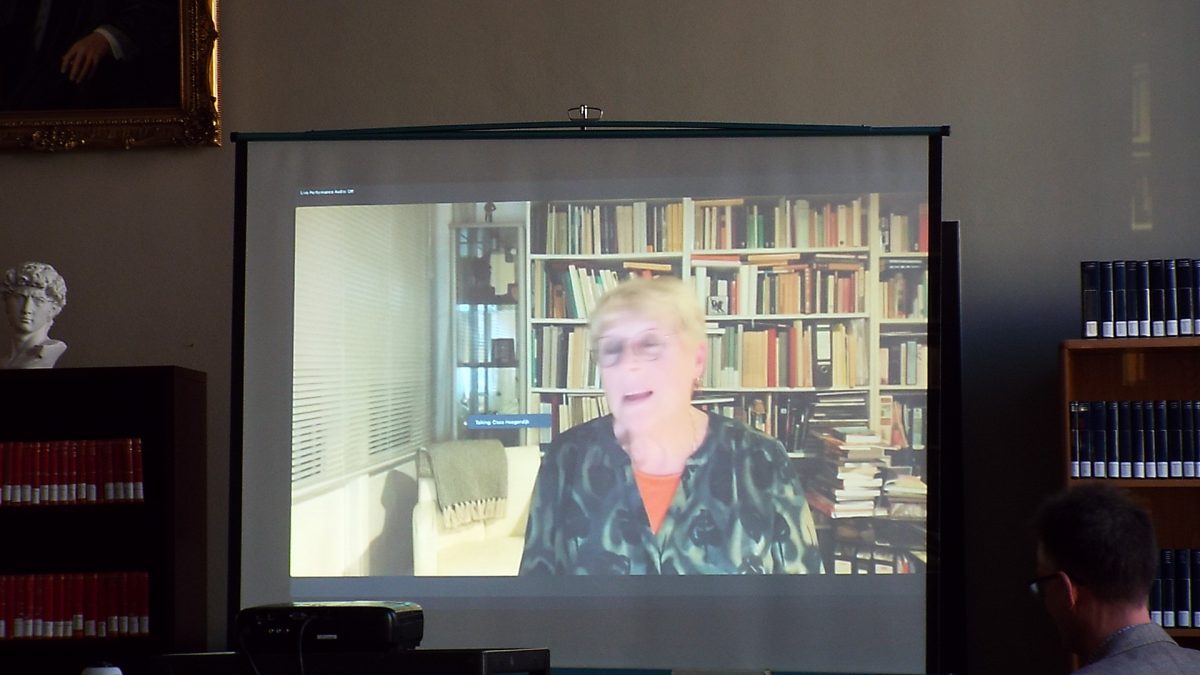
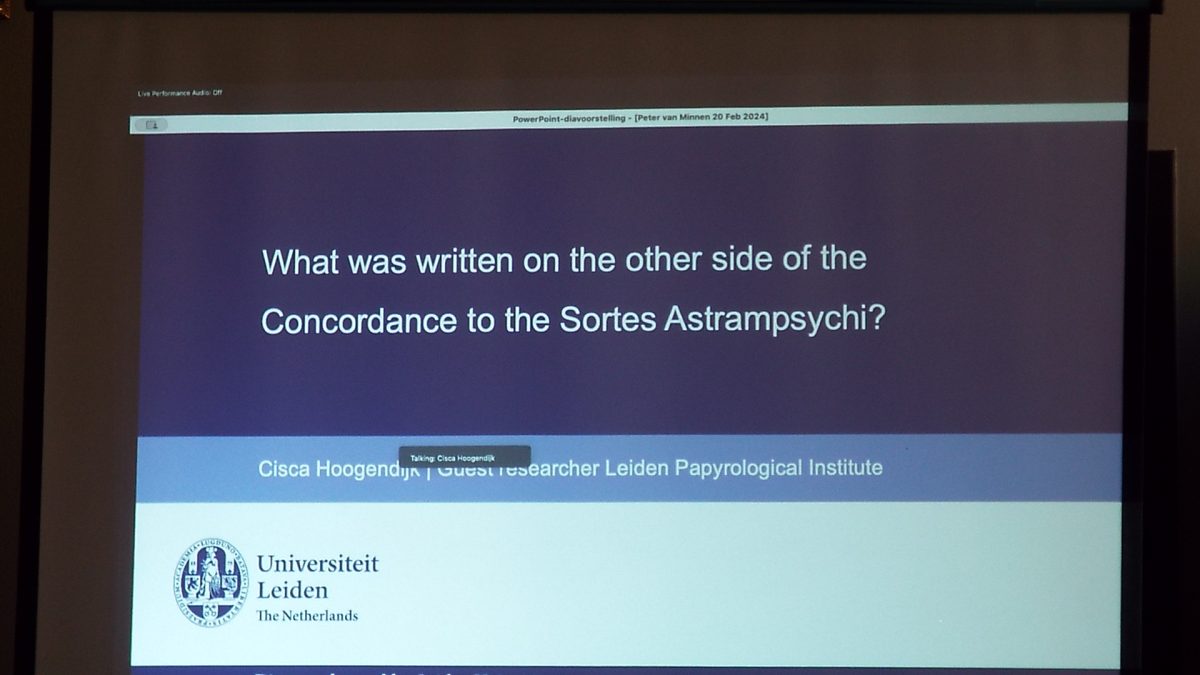
Dr. Cisca Hoogendijk’s talk.
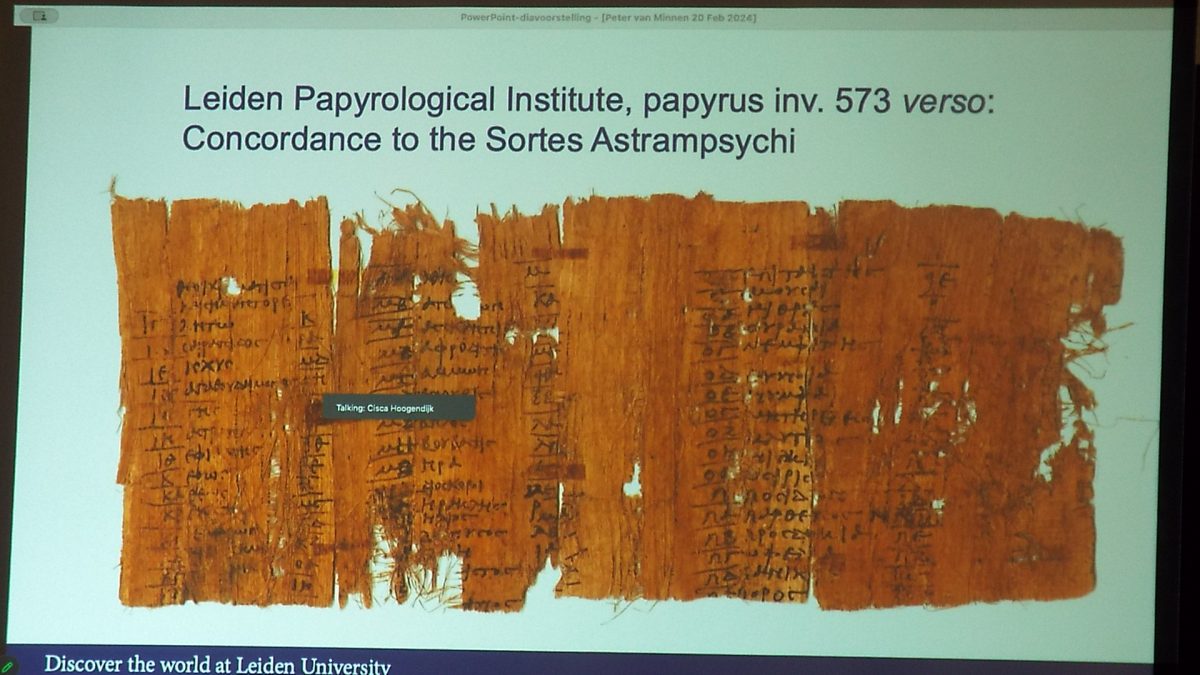
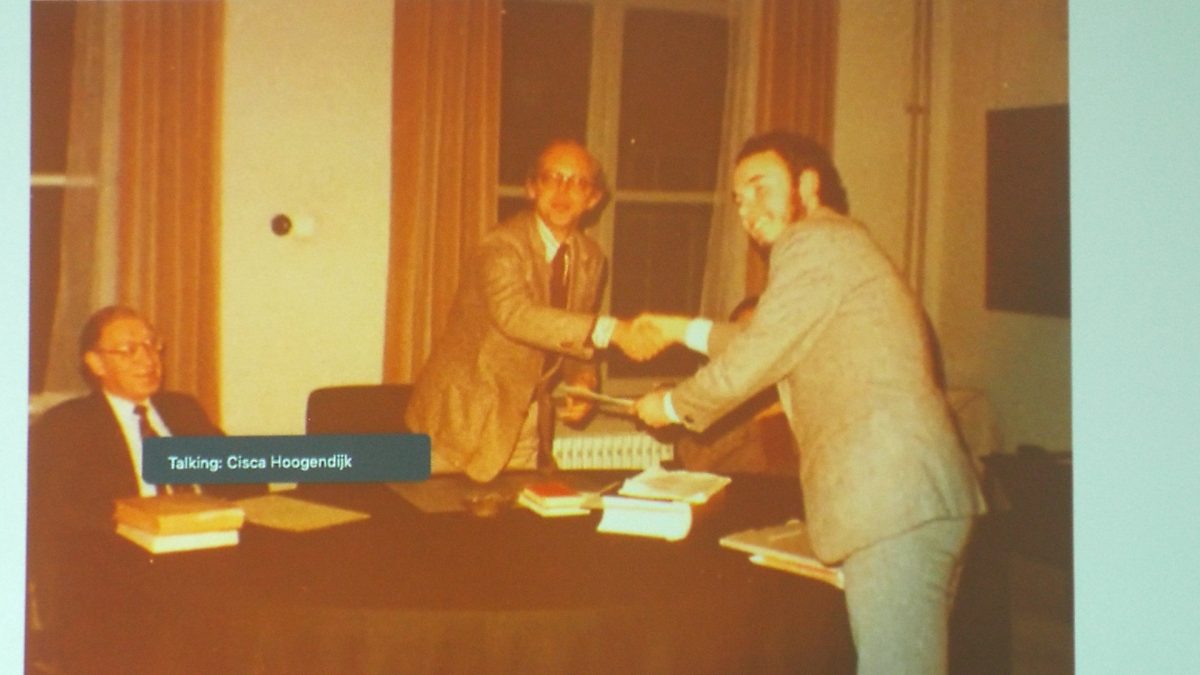
Dr. Hoogendijk included photos of a young Peter van Minnen at the University of Leiden.
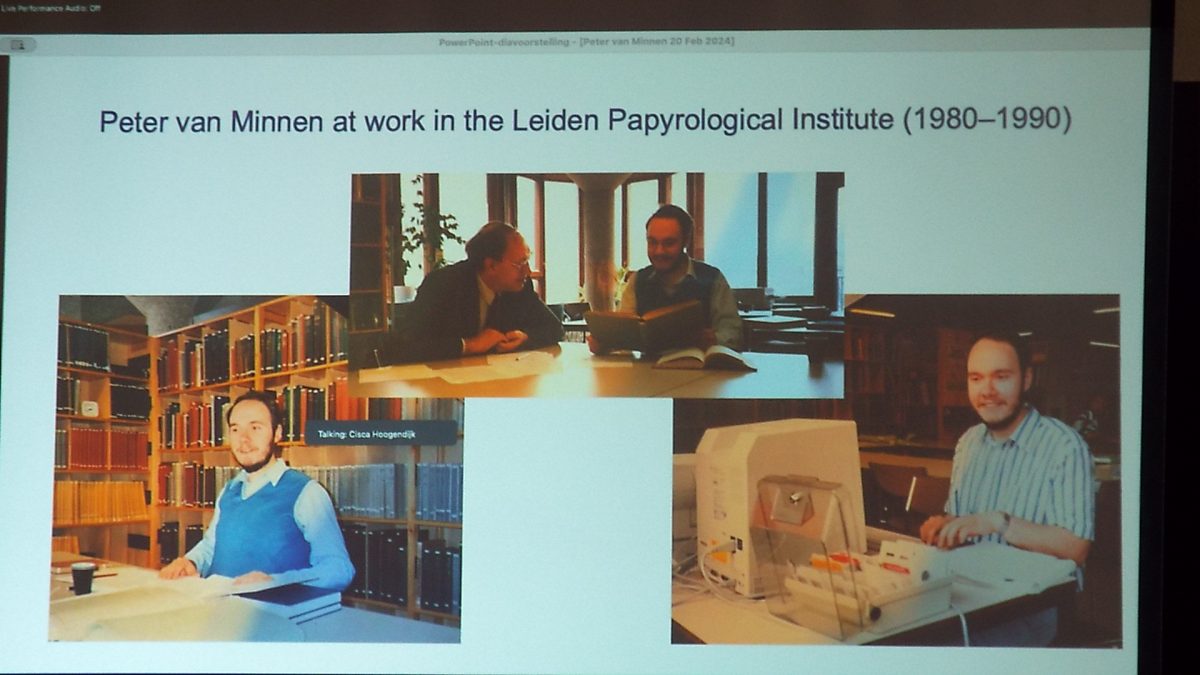
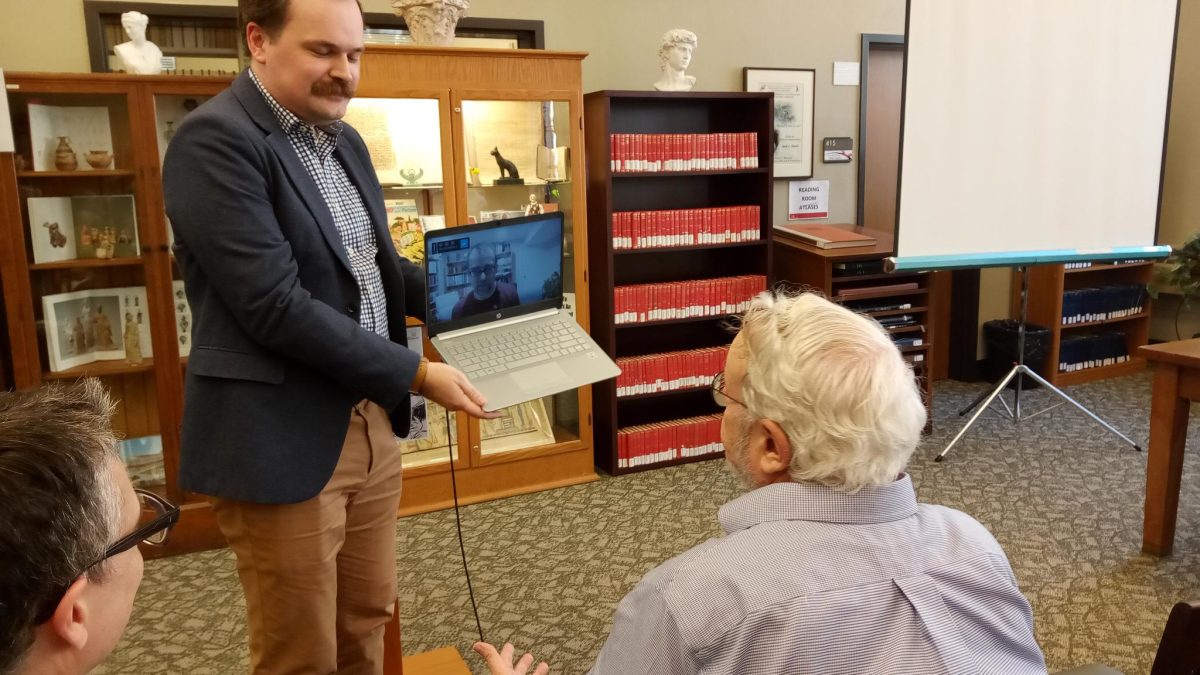
Dr. Jitse Dijkstra, co-editor of the Festschrift, honored van Minnen from his excavation in Egypt, describing the steps involved in the creation of the Festschrift.
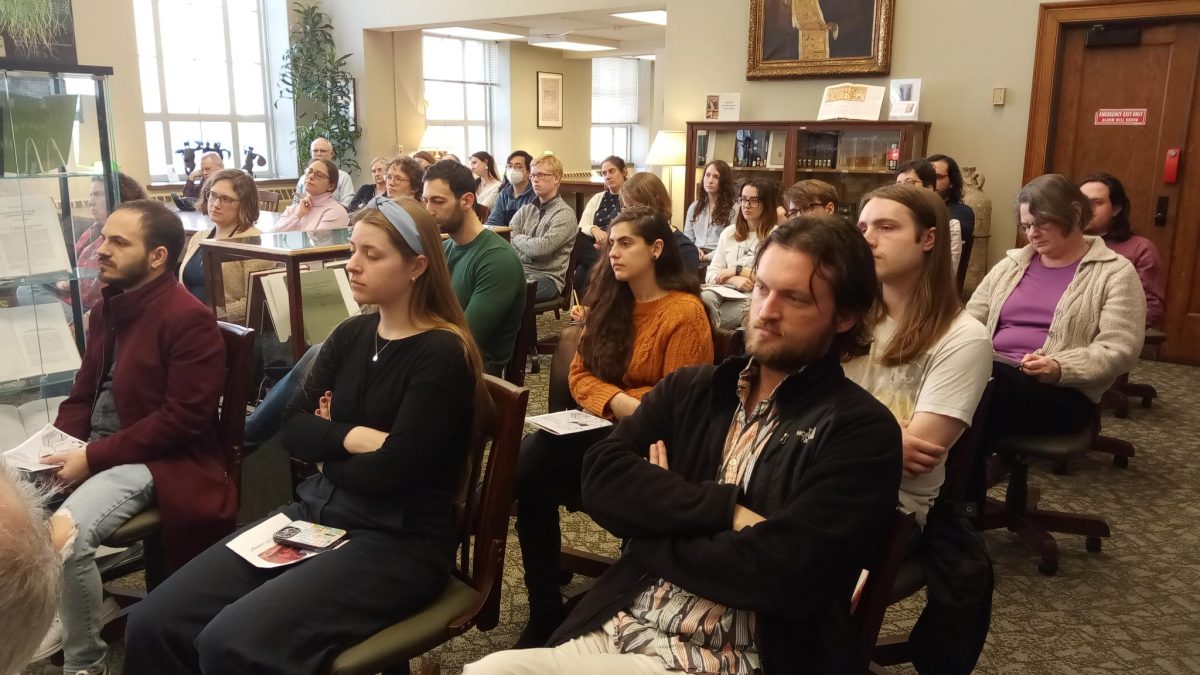
Every chair in the Library was occupied by the many who came to celebrate Professor van Minnen.


Dr. Andrew Connor presents the Festschrift to Peter van Minnen.
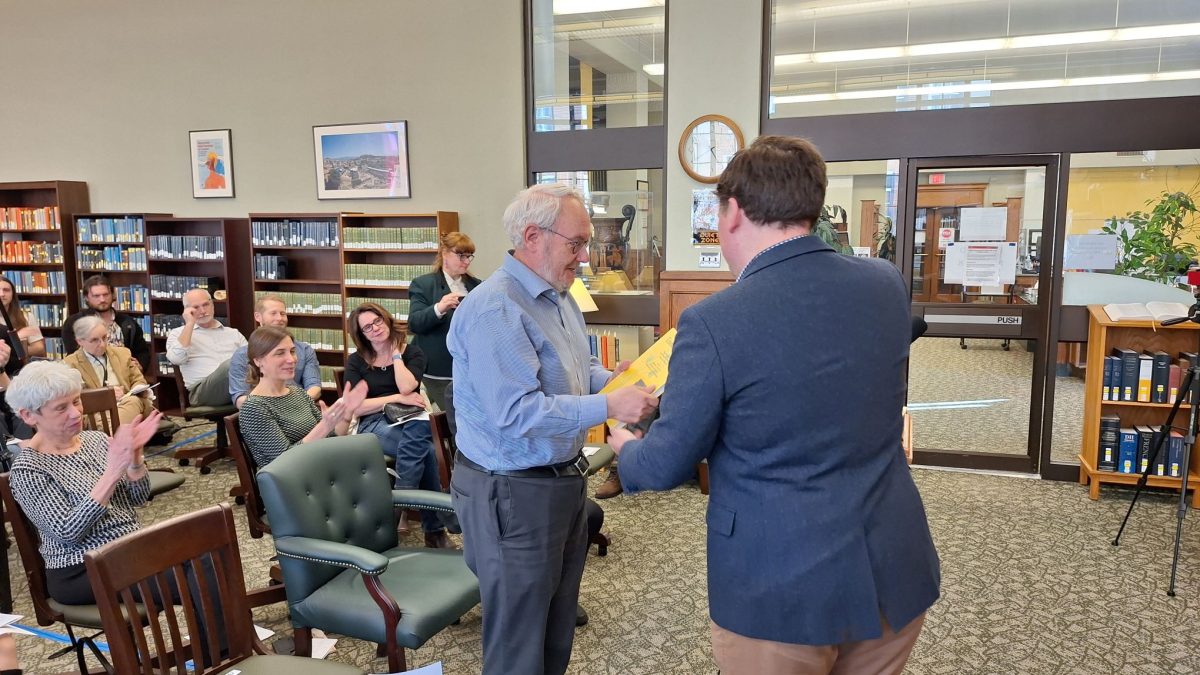

Professor van Minnen thanks the organizers.
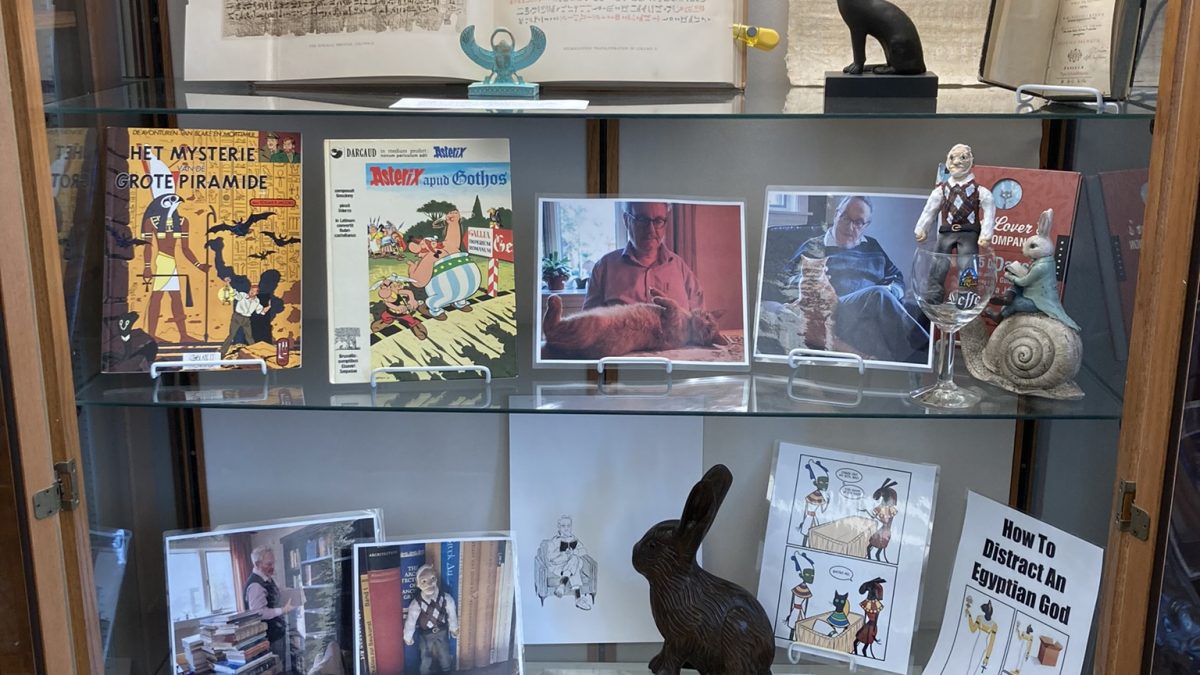
A display featuring comic books van Minnen read as a boy, photos of him and his and his wife’s cat Lobster, a couple of Peter Rabbit figurines, a drawing and doll representing the honoree created by his wife Dr. Angelica Wisenbarger, UC.
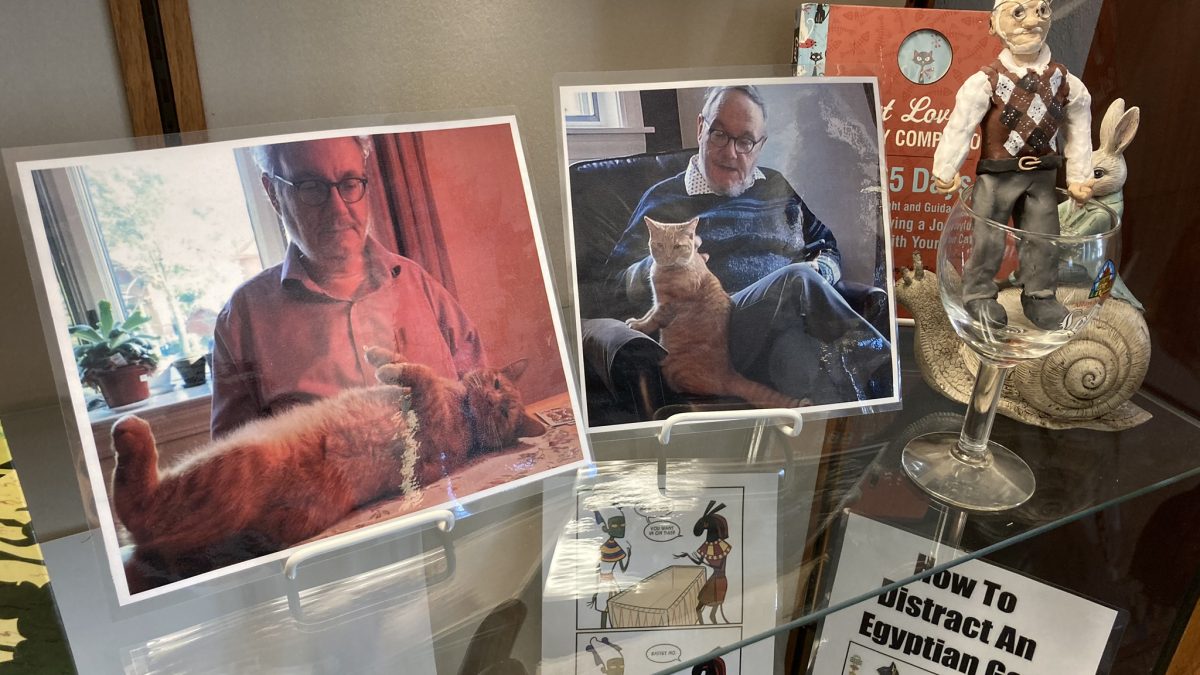
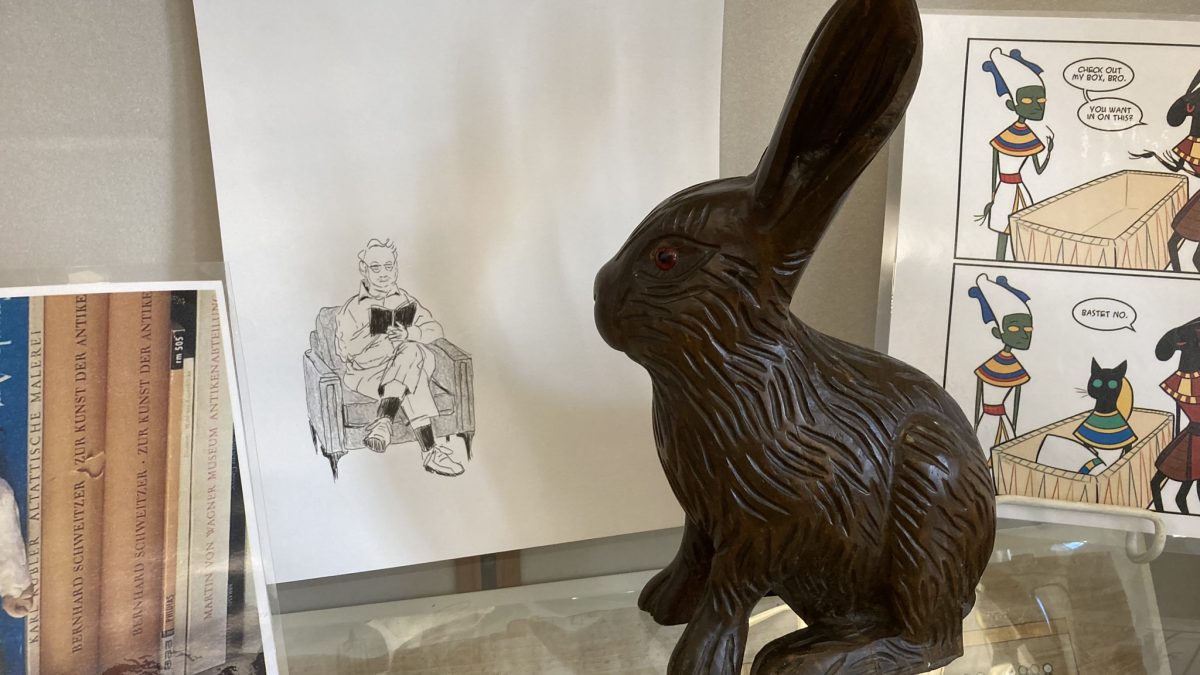
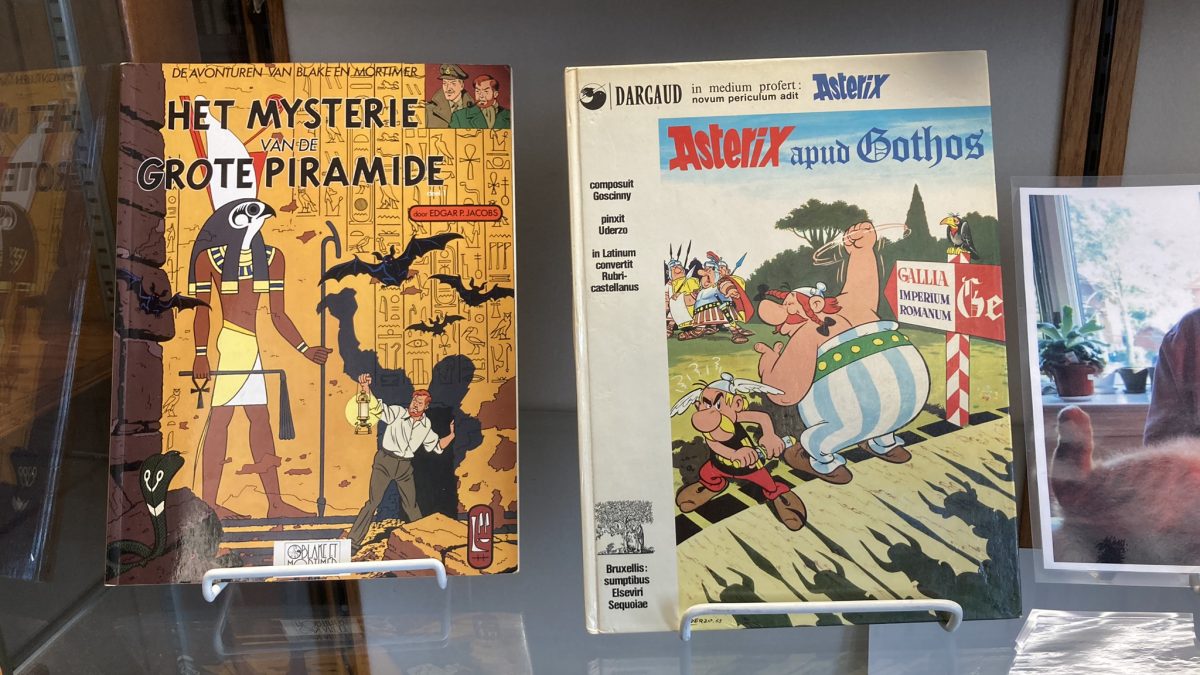
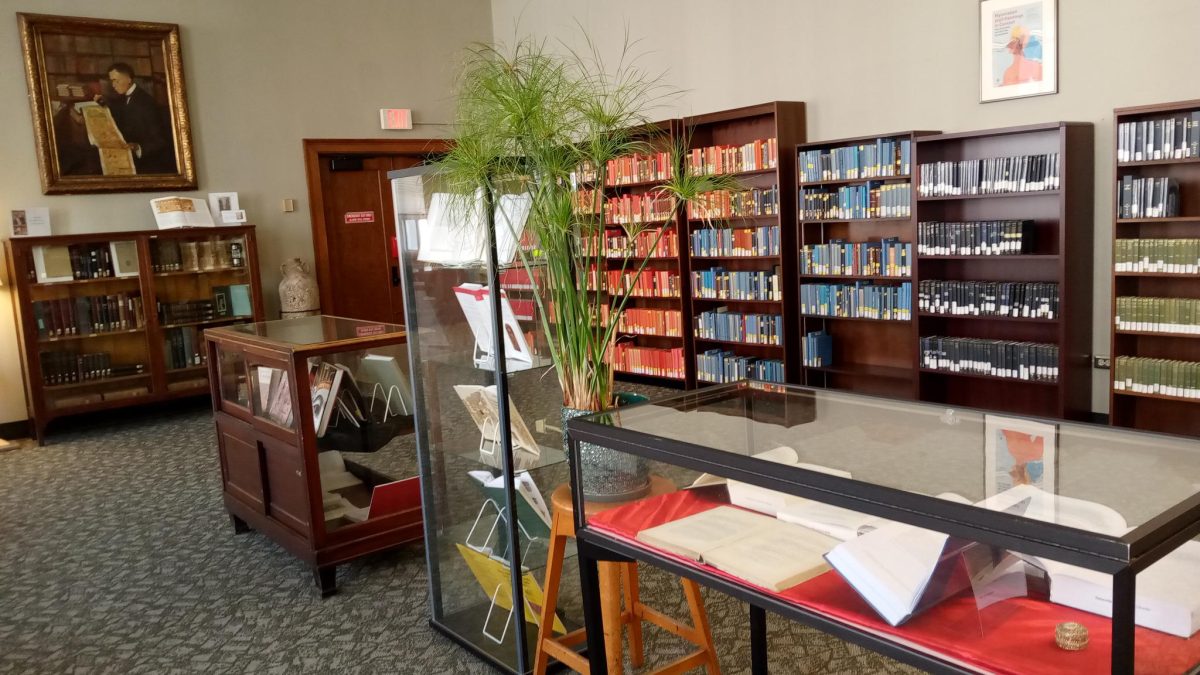
Exhibition featuring some of van Minnen’s most influential publications.
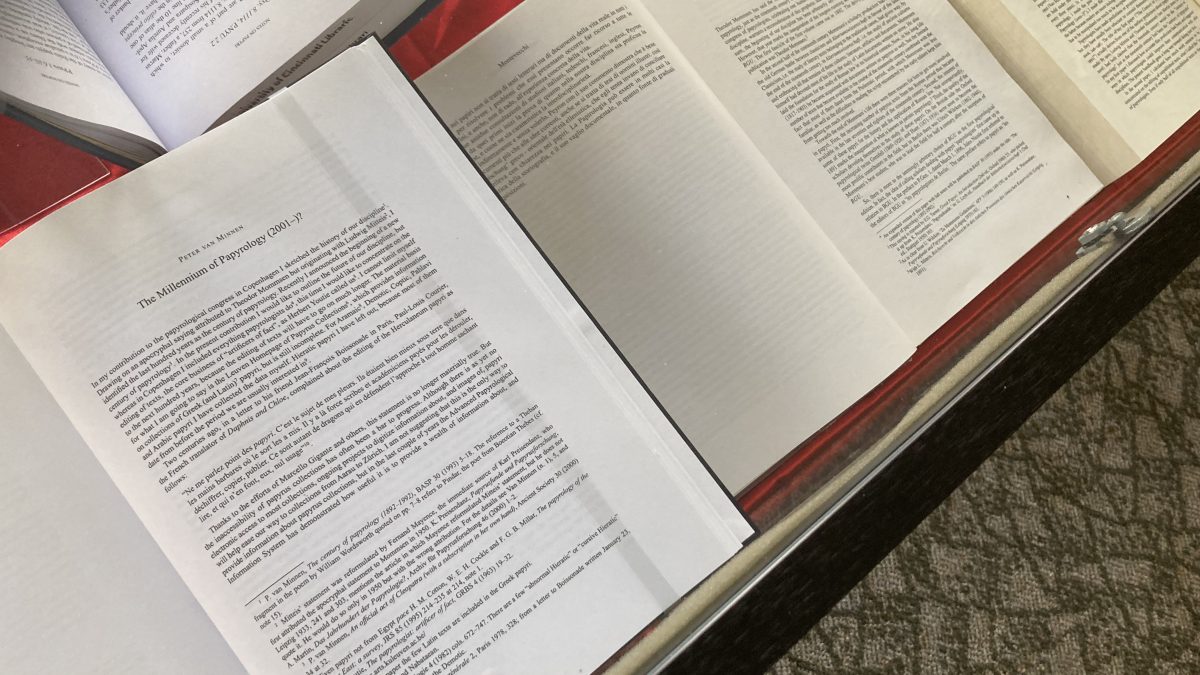
“The Millennium of Papyrology.”
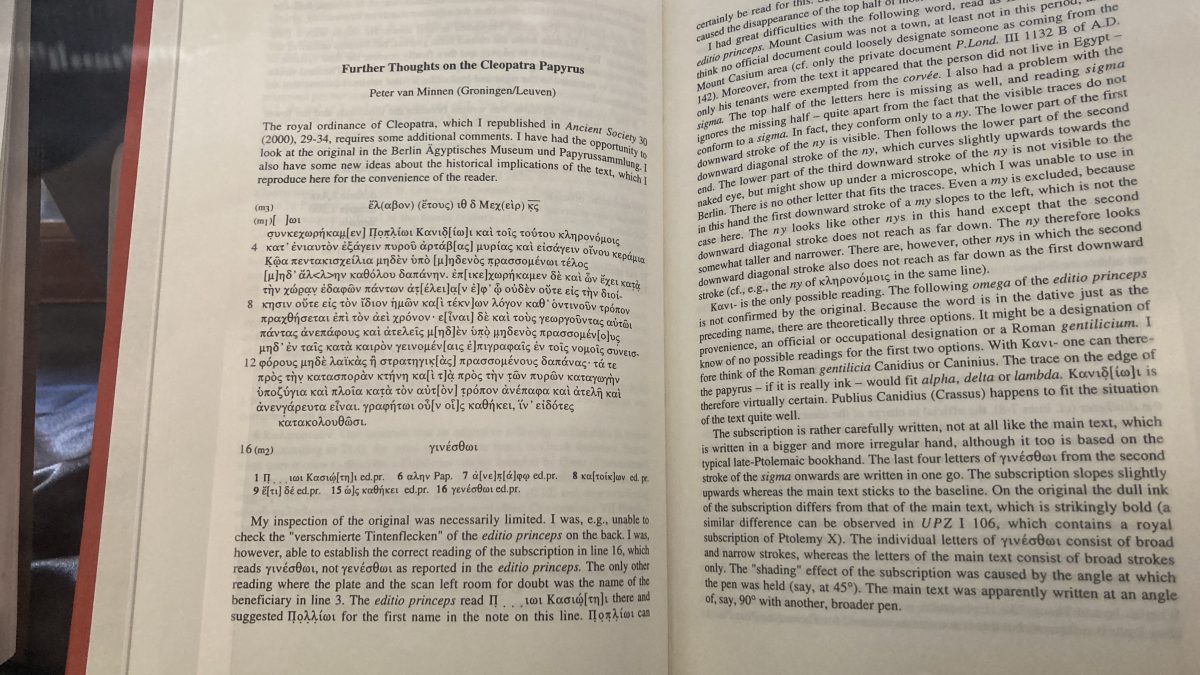
“Further Thoughts on the Cleopatra Papyrus.”
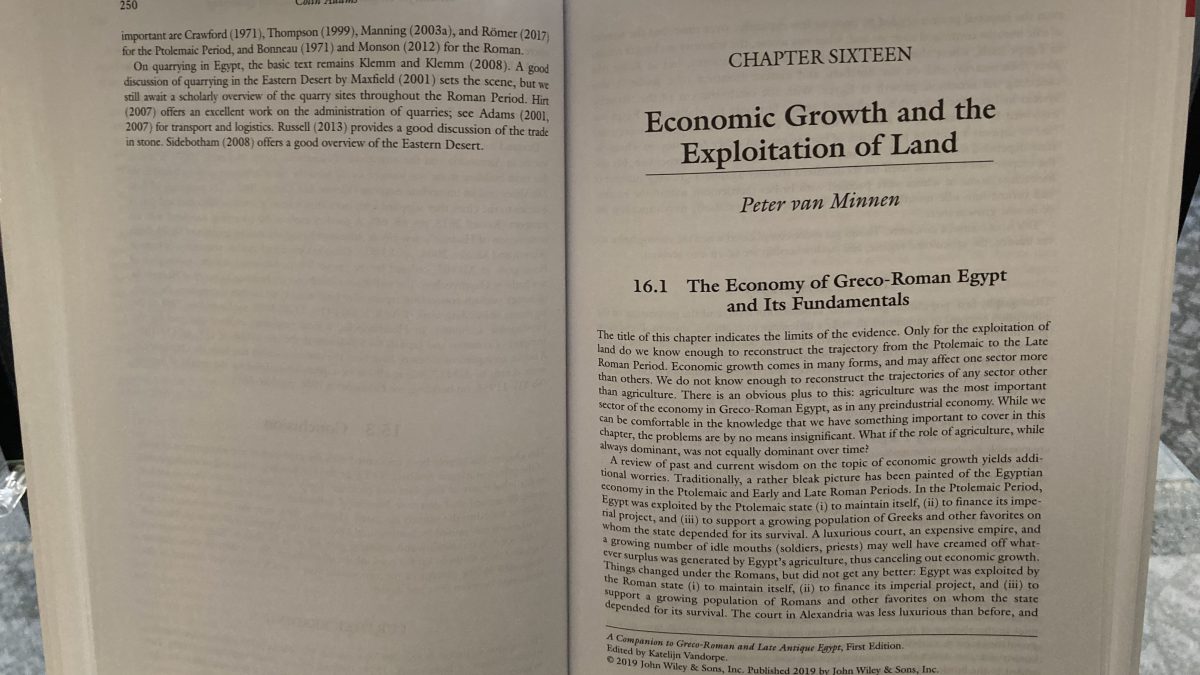
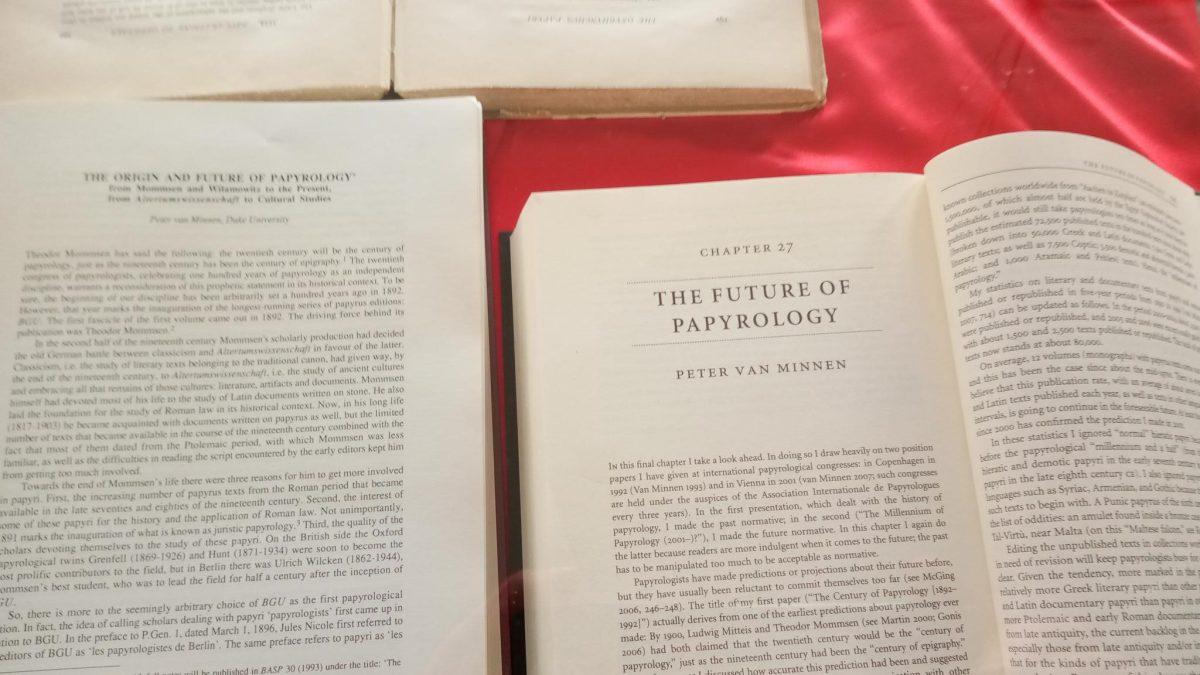
“The Future of Papyrology.”
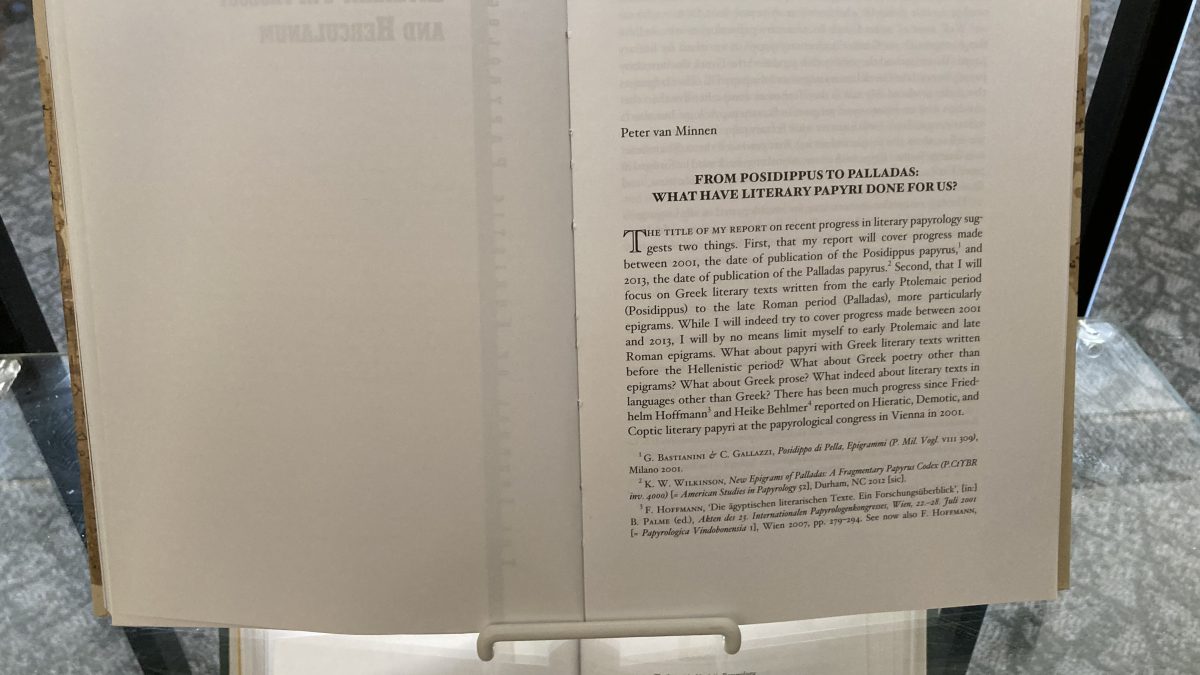
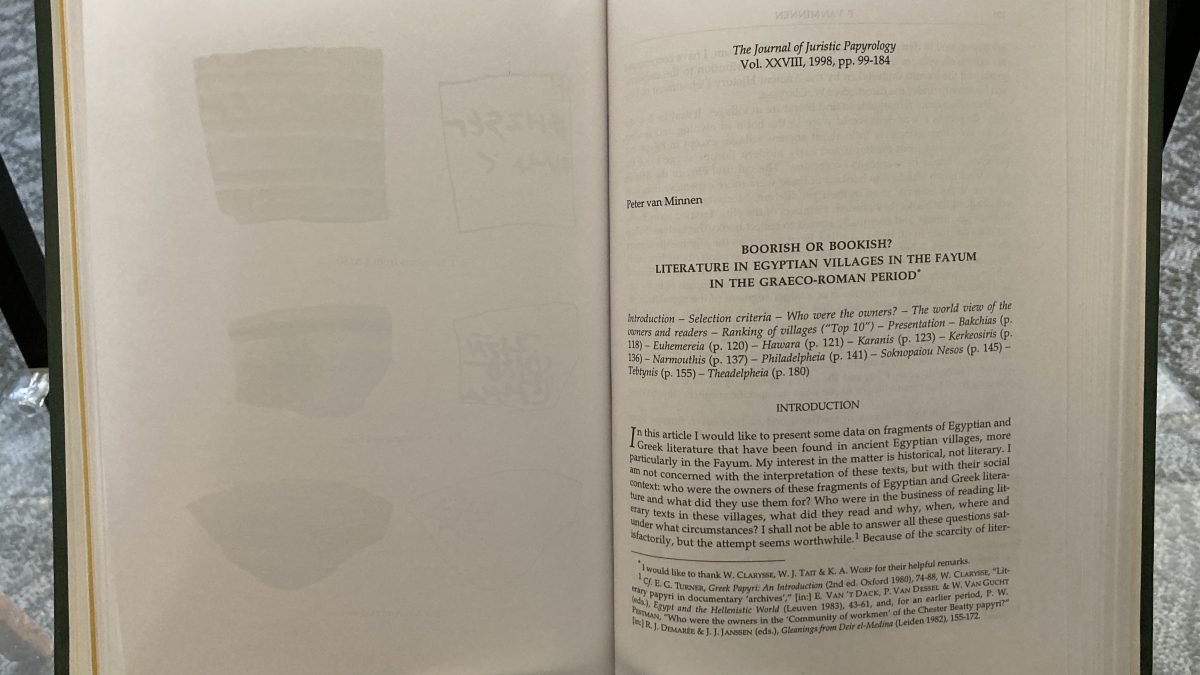
“Bookish or Boorish.”
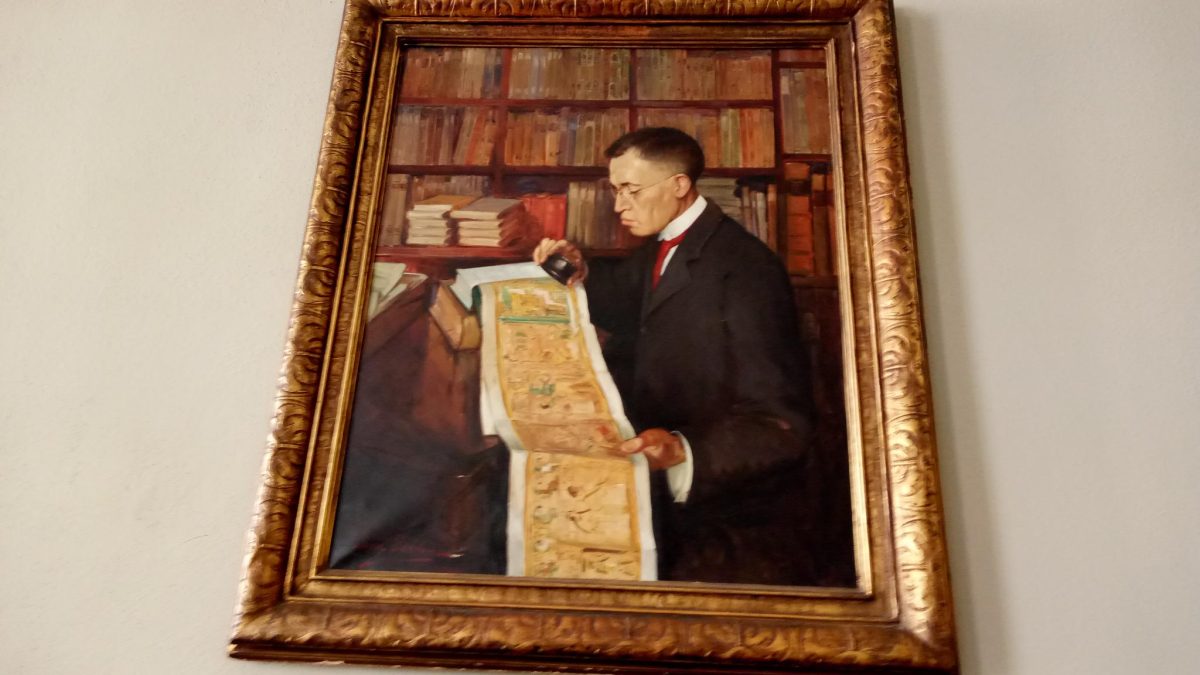
The title of van Minnen’s professorship is named after the man in the portrait, John Miller Burnam, Professor of Latin Palaeography and Romance Languages, 1900-1921, and the namesake of the Classics Library and a room dedicated to the field of palaeography.
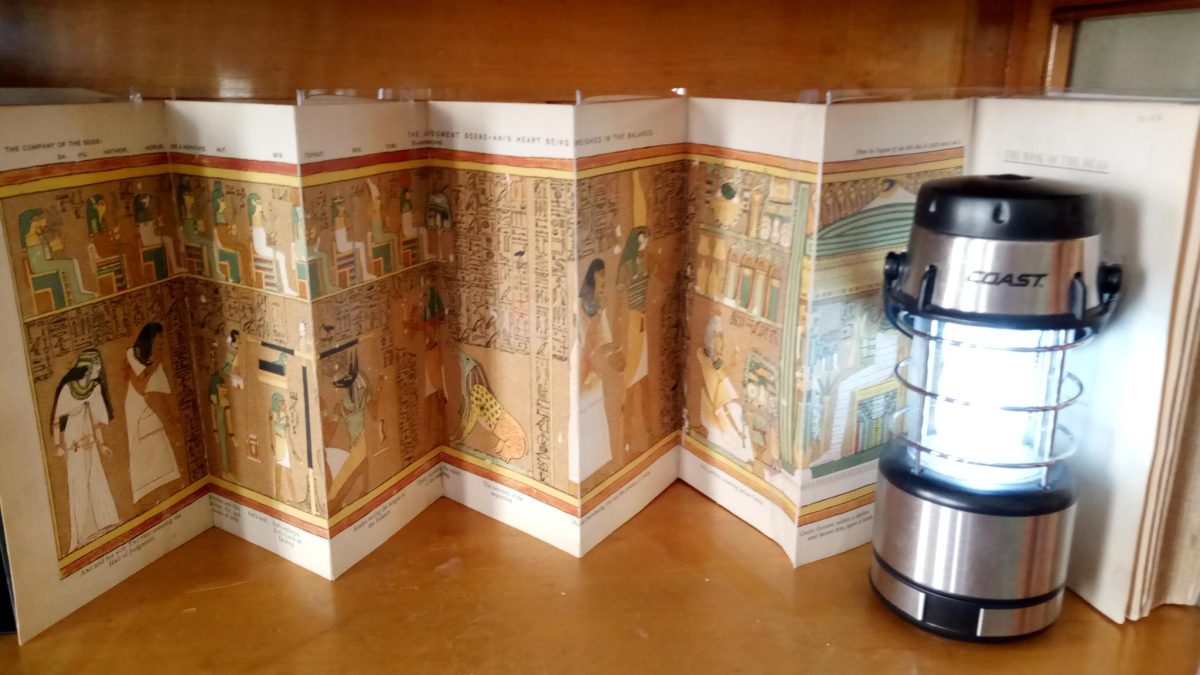
In the portrait of John Miller Burnam (above), he is examining a facsimile of the Egyptian Book of the Dead; the same copy is housed in the case below the portrait.
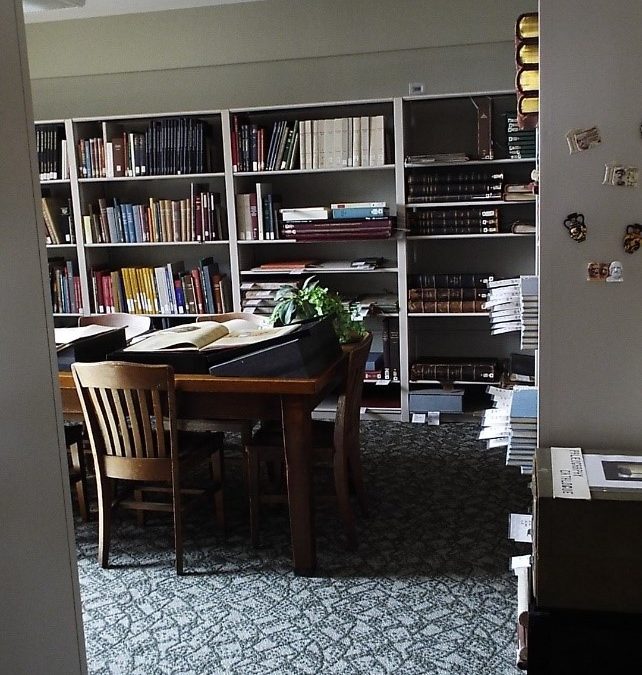
The John Miller Burnam Palaeography Library nicknamed “The Scriptorium” by Professor van Minnen (room 414A).
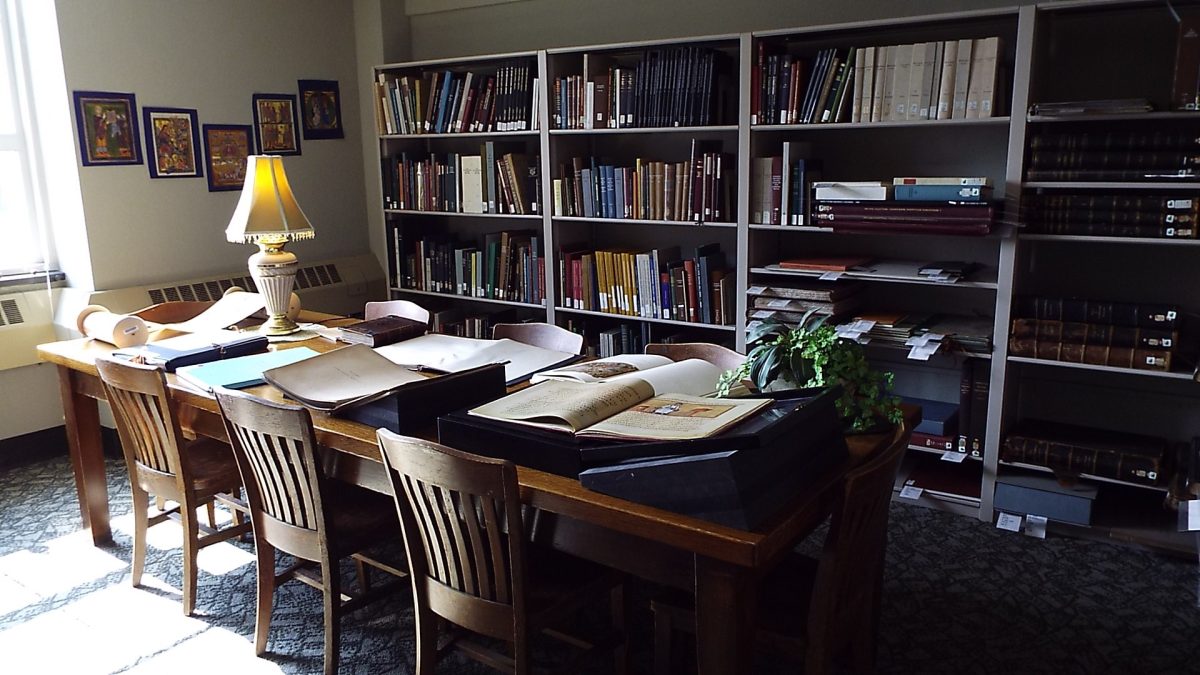
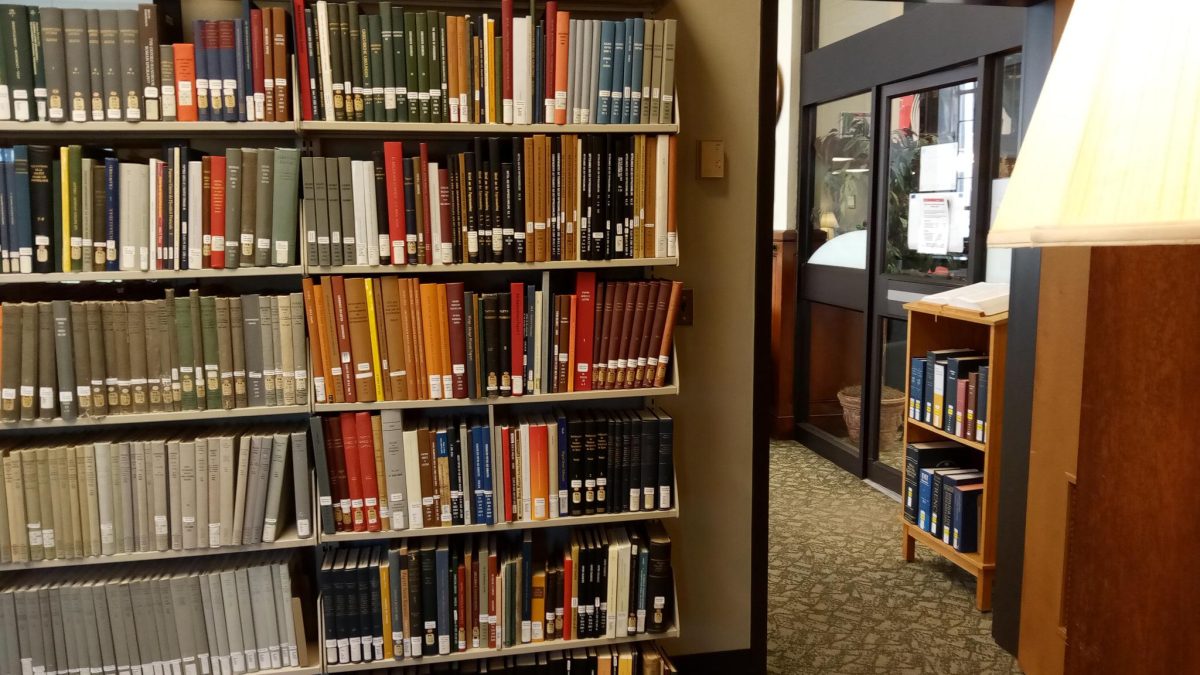
The new Epigraphy and Papyrology Reading Room (room 416).
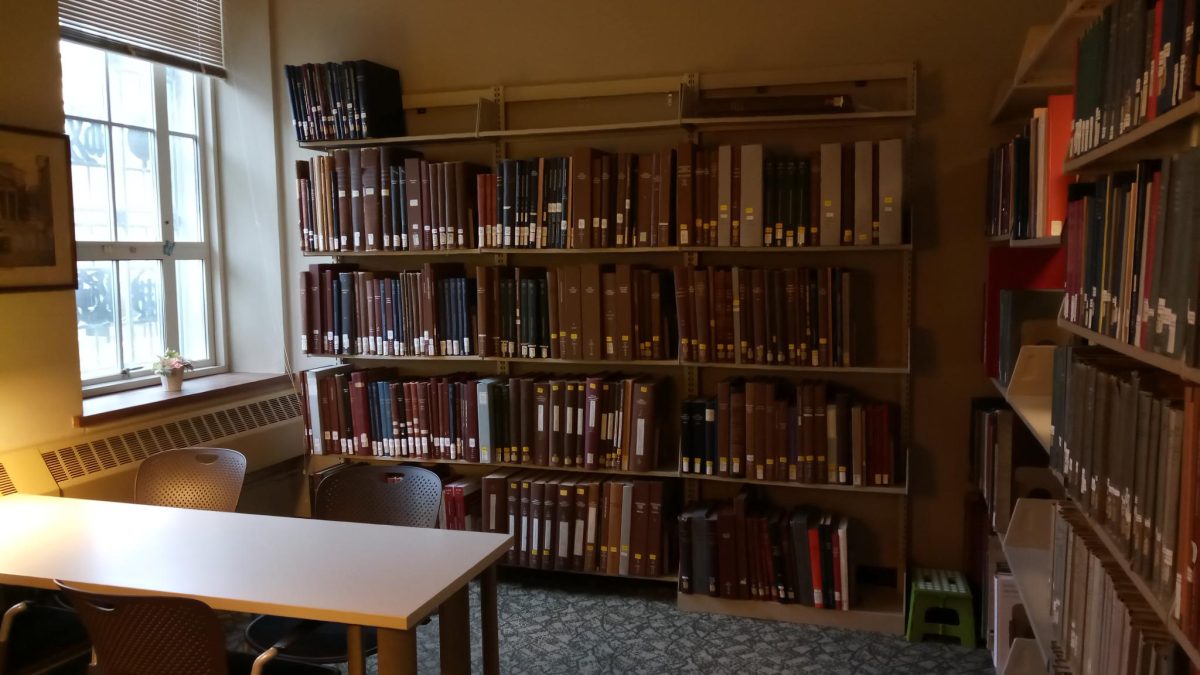
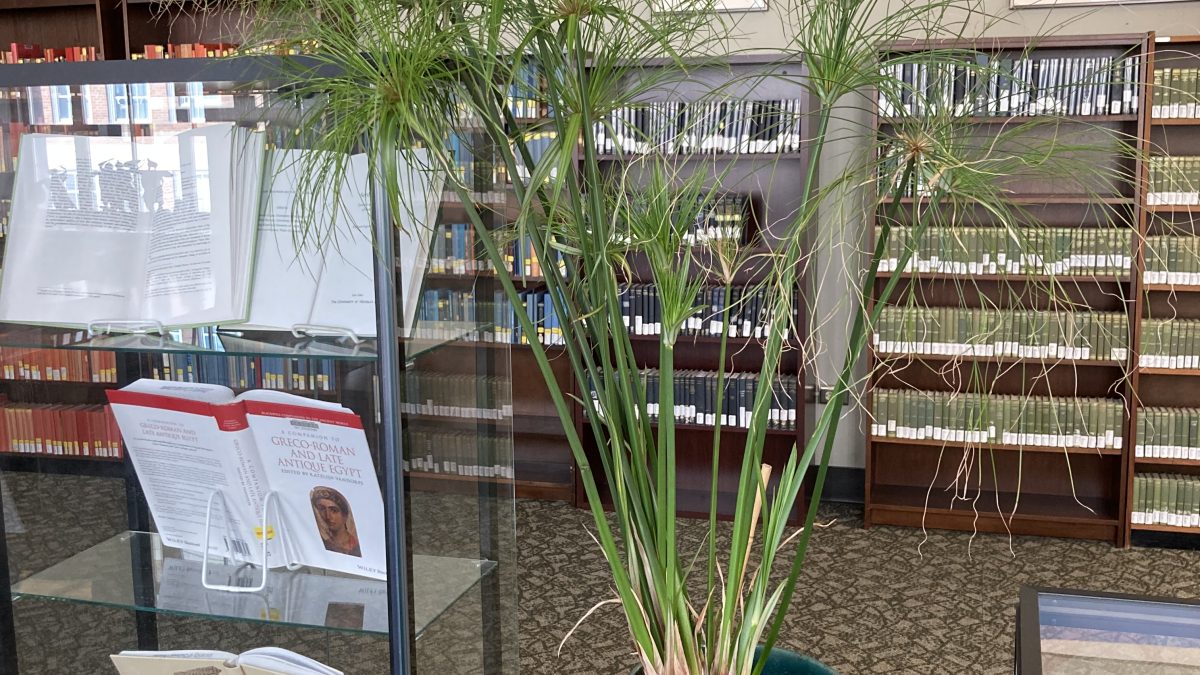
Papyrus plant on loan from John Wallrodt. Papyrus was used in antiquity to produce material for writing.
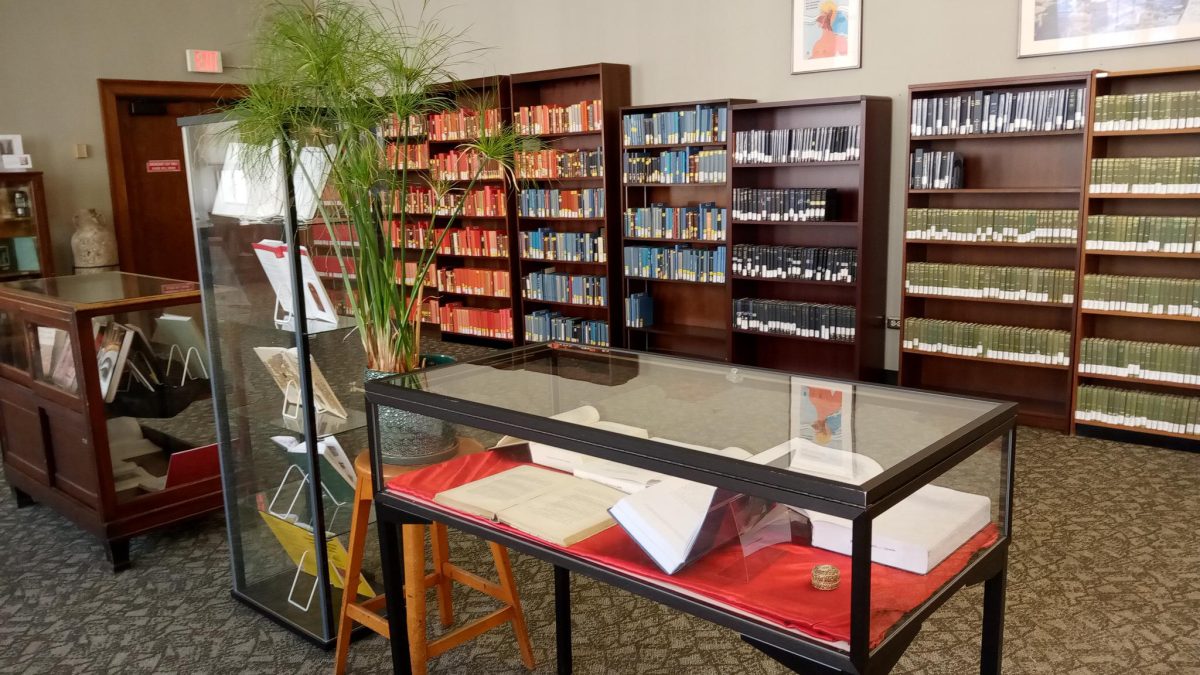
The reading room with the exhibition and ancient text editions (Budé, Teubner, OCT, Loeb) along the walls.

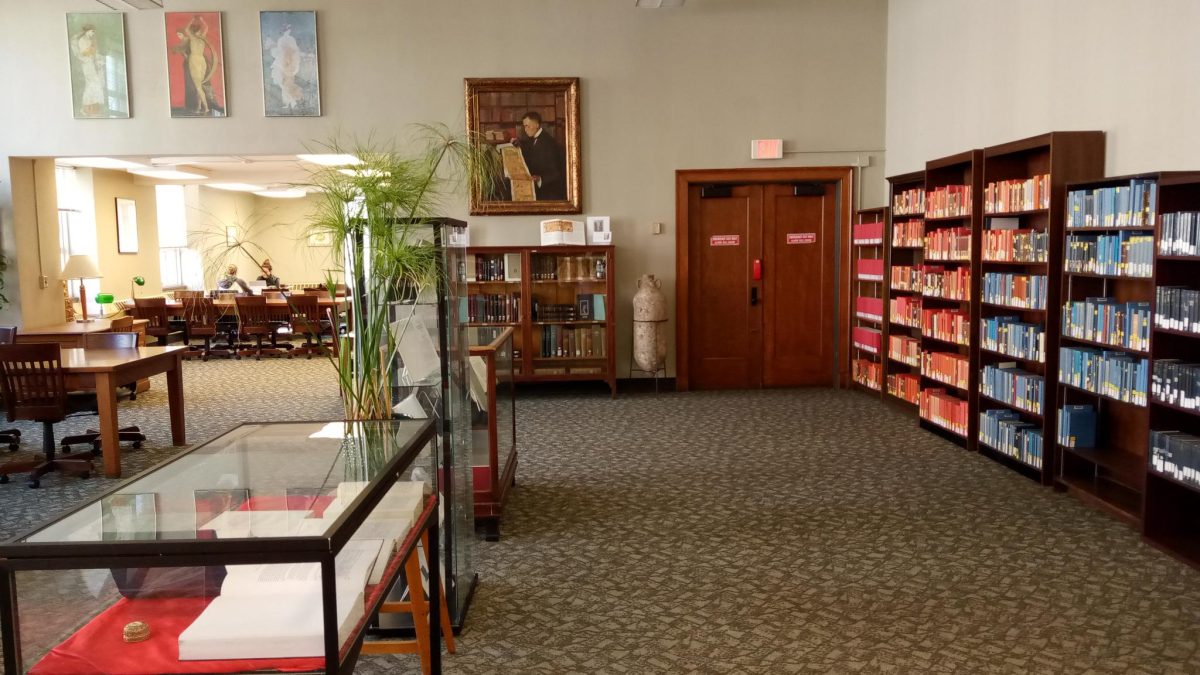
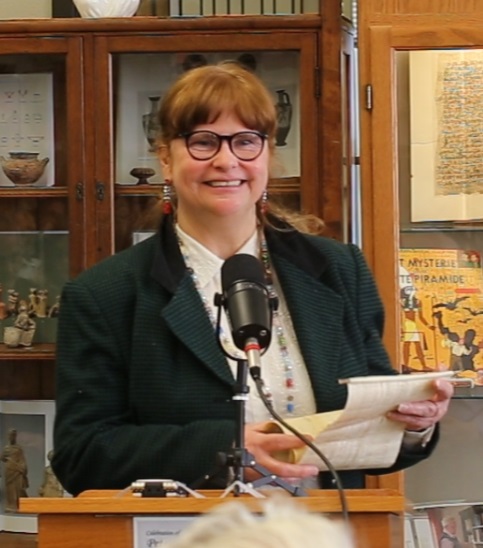
For the occasion, the head of the Classics Library read her talking points from a papyrus.
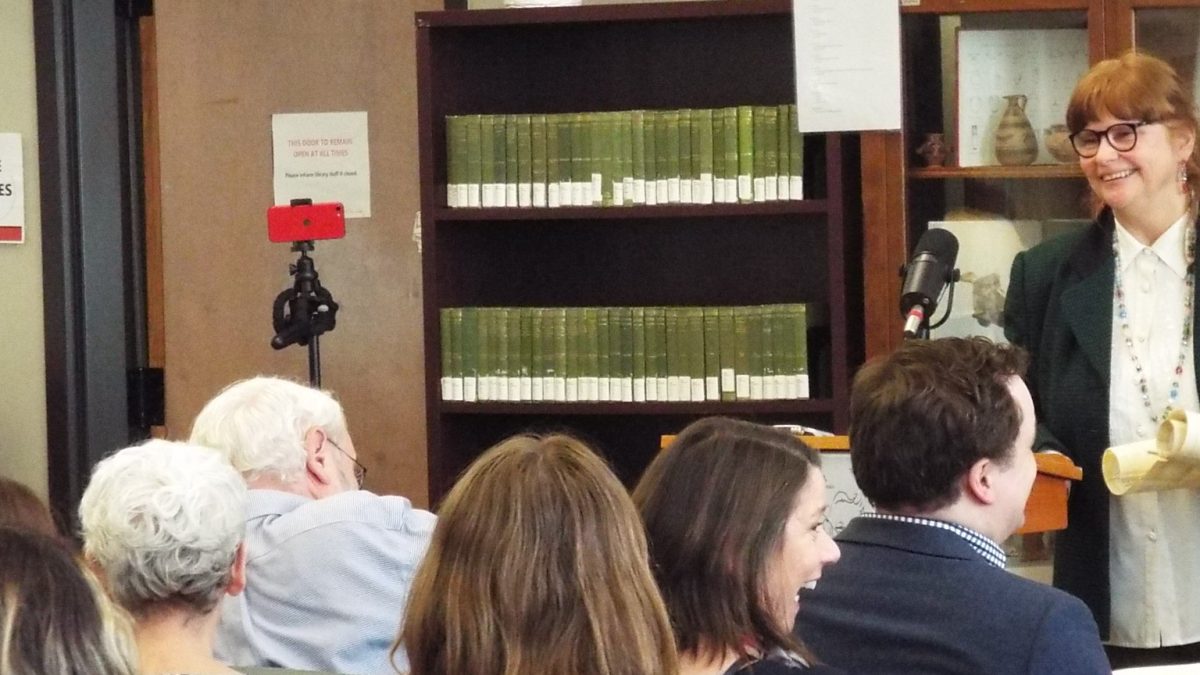
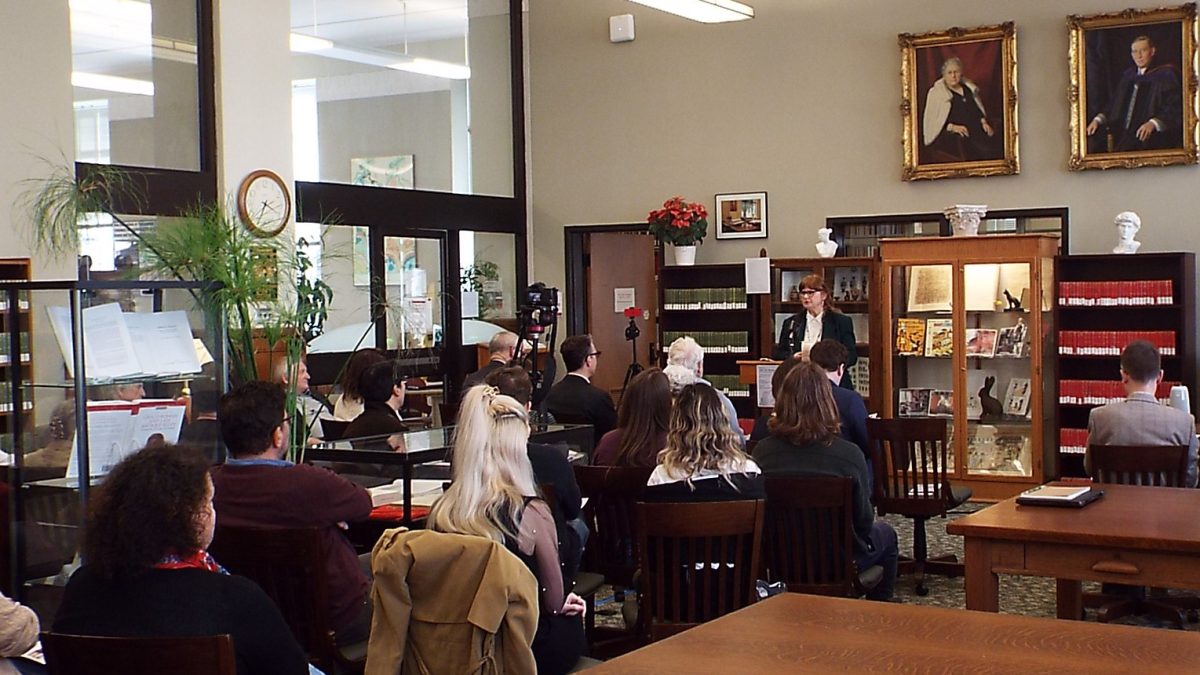
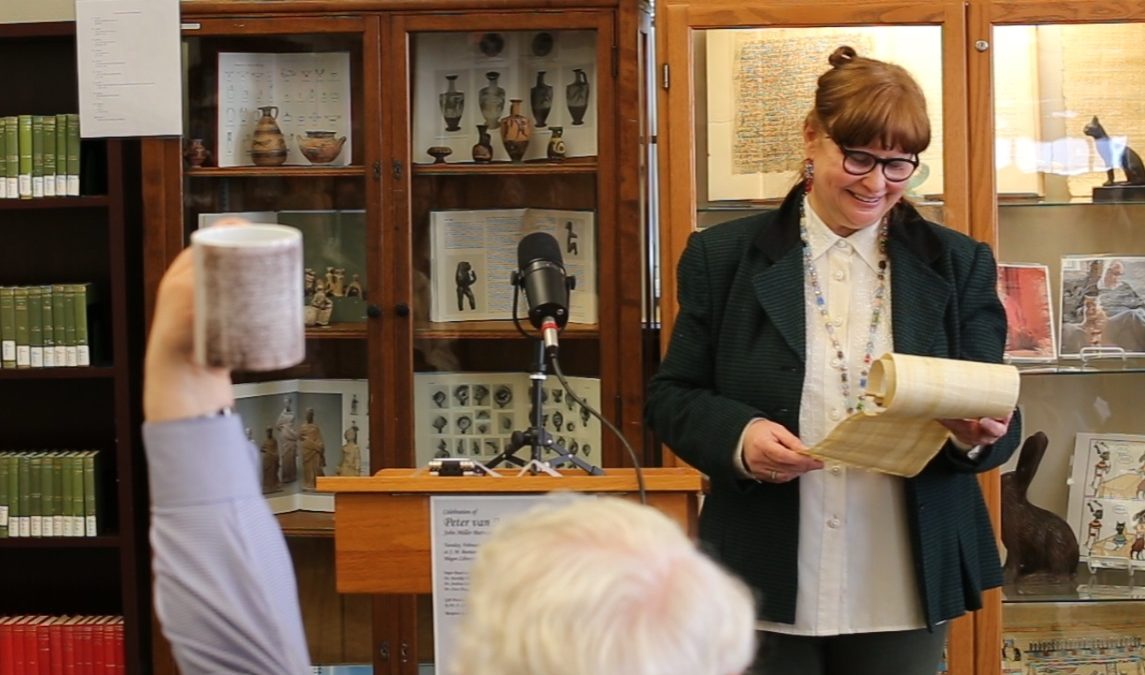
The head of the Classics Library lauded van Minnen’s generous help to the library; for example, van Minnen donating countless books, lending interesting and quirky artifacts for library exhibitions, helping to select materials for the “John Miller Burnam Palaeography Library” (room 414A) and the recent addition “Epigraphy and Papyrology Reading Room” (room 416), composing exhaustive bibliographies/library checklists for titles in papyrology, epigraphy, and numismatics, and much more, earning him the unofficial title “honorary librarian.” As a small token of appreciation she gave him a mug featuring a section of the famous Edwin Smith Papyrus (the section was represented in a facsimile in one of the displays) and lapel pins of a library index card and a library stamp.

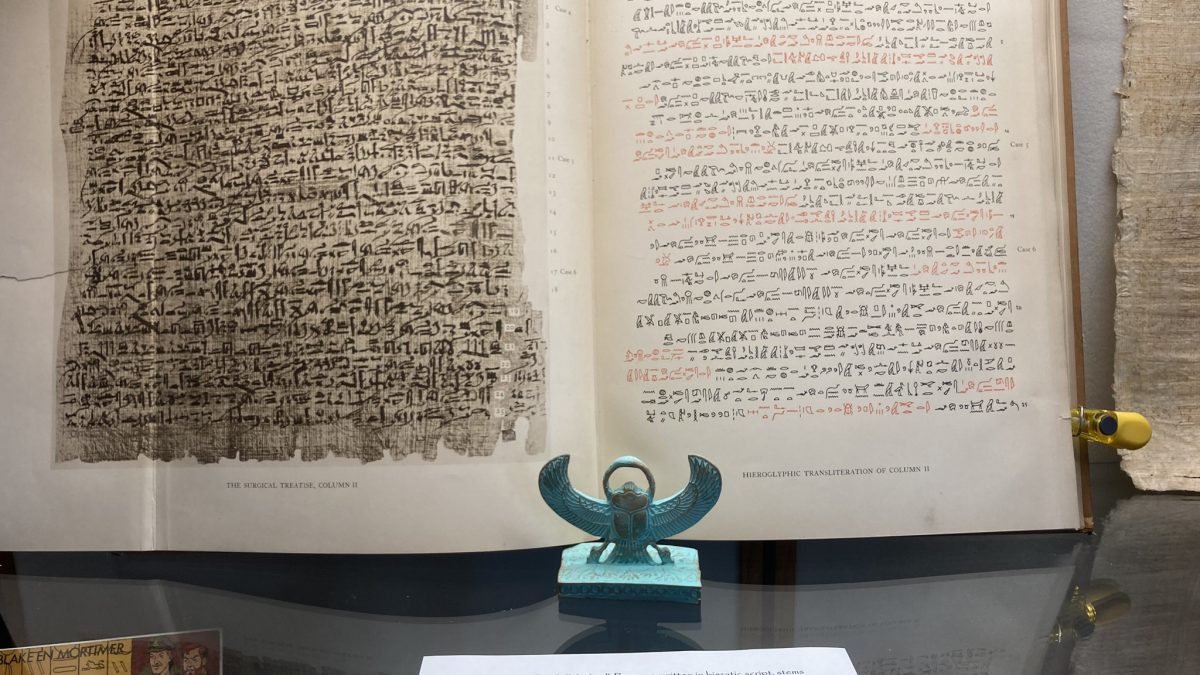
The section of the Edwin Smith papyrus displayed is the one featured on the mug.
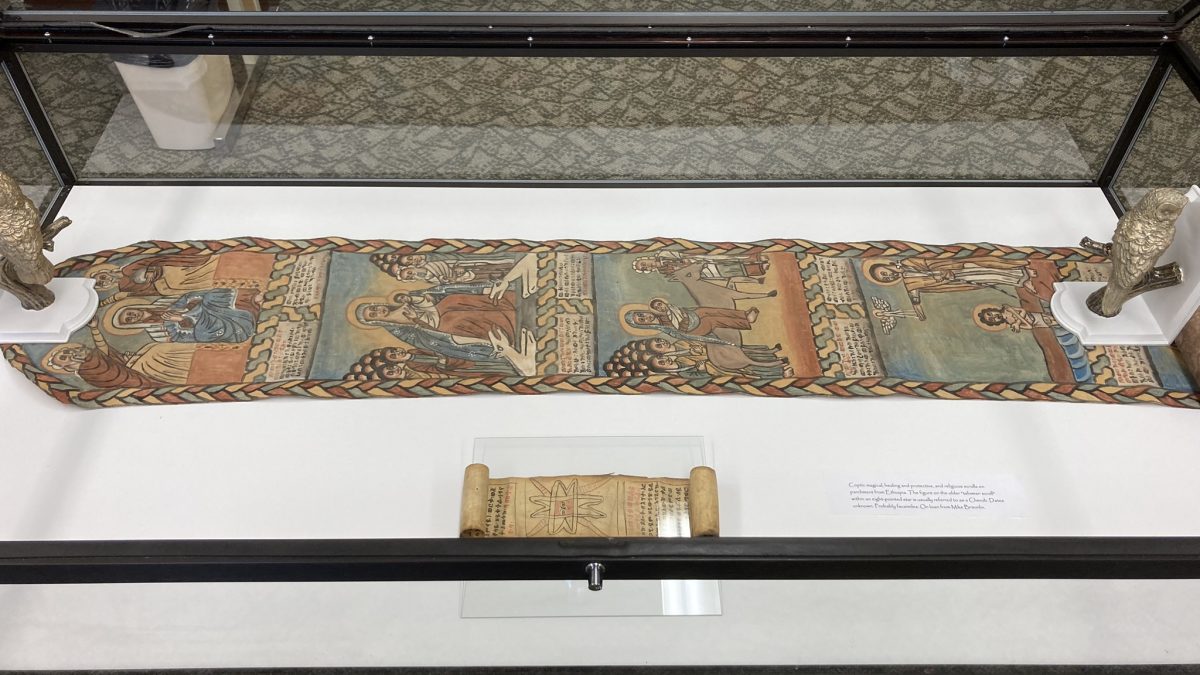
The Library’s bibliographer, Mike Braunlin, lent two amazing Coptic scrolls on parchment from Ethiopia to the Library. This is one of van Minnen’s interests as the first editor of the earliest dated Coptic martyrdom. Scrolls like these from Ethiopia are generally magical, healing and protective, and/or religious in nature. The figure on the older “talisman scroll” within an eight-pointed star is usually referred to as a Cherub. Dates unknown.
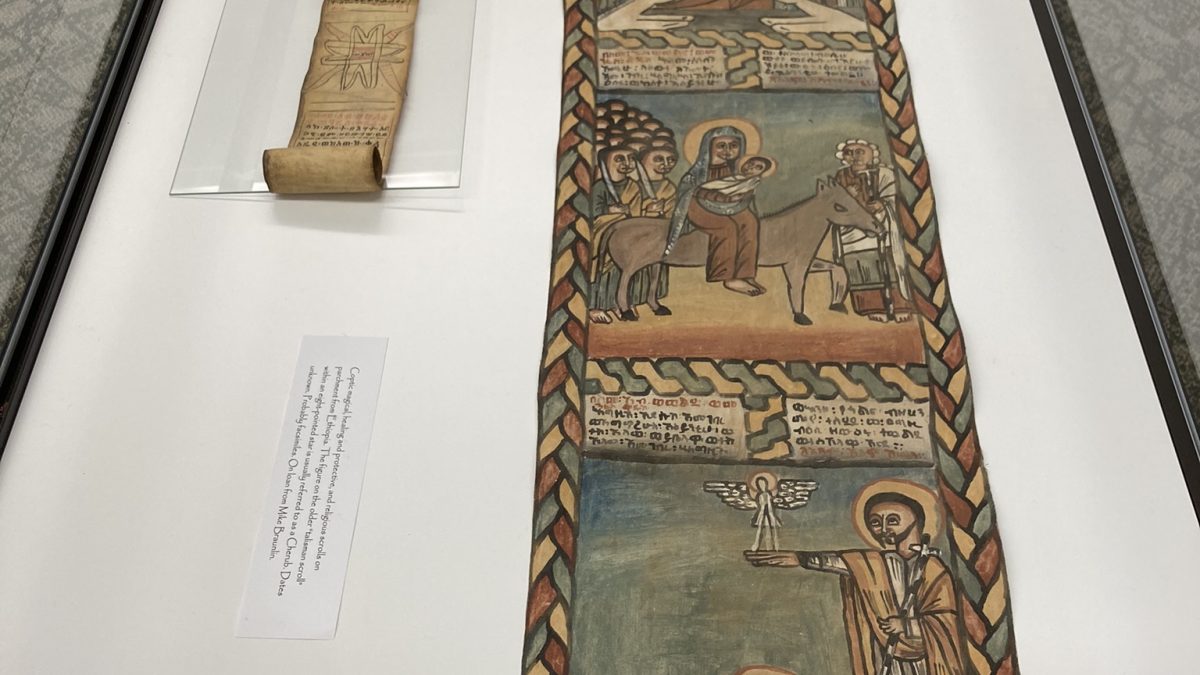
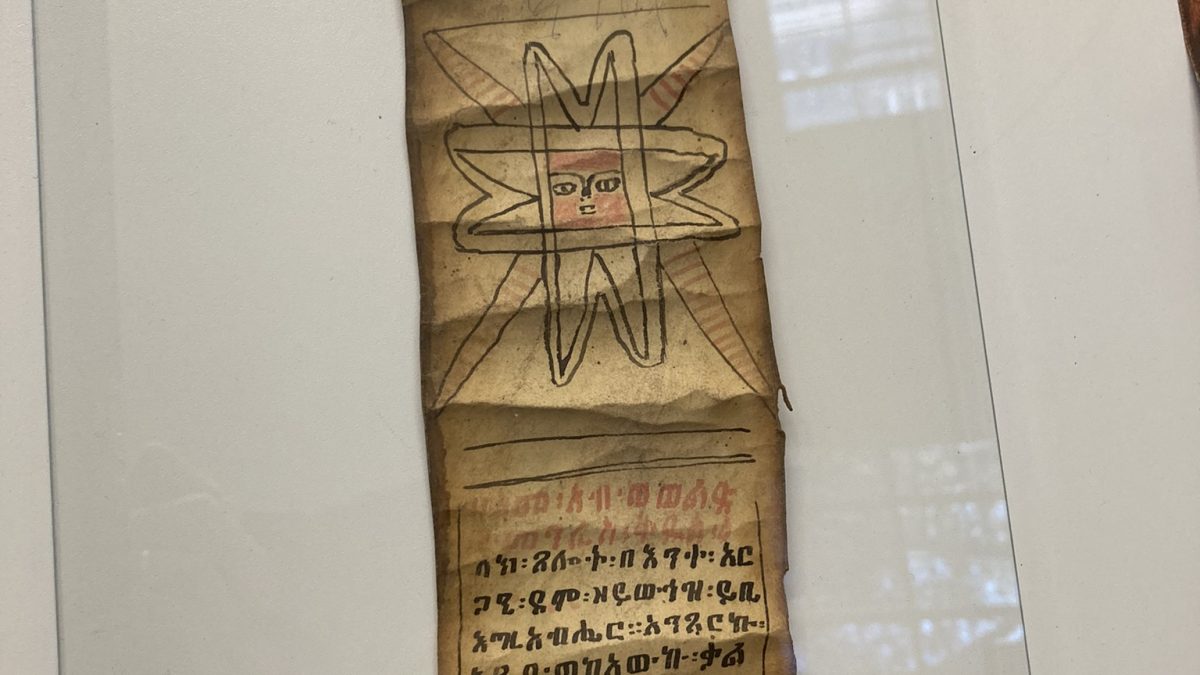
The older scroll depicts a “cherub.”
The participants in the American Society of Papyrology Summer Institute 2005 headed by Professor van Minnen and held at the University of Cincinnati.
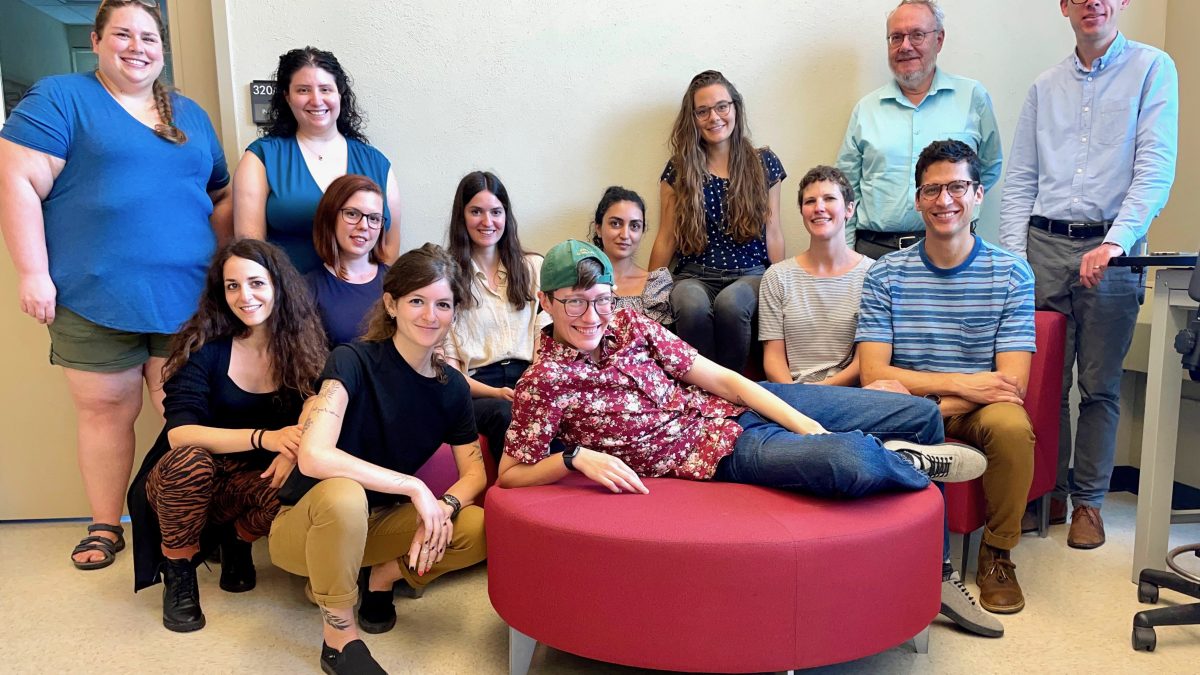
The participants in the American Society of Papyrology Summer Institute 2022 headed by Professor van Minnen and held at the University of Cincinnati.
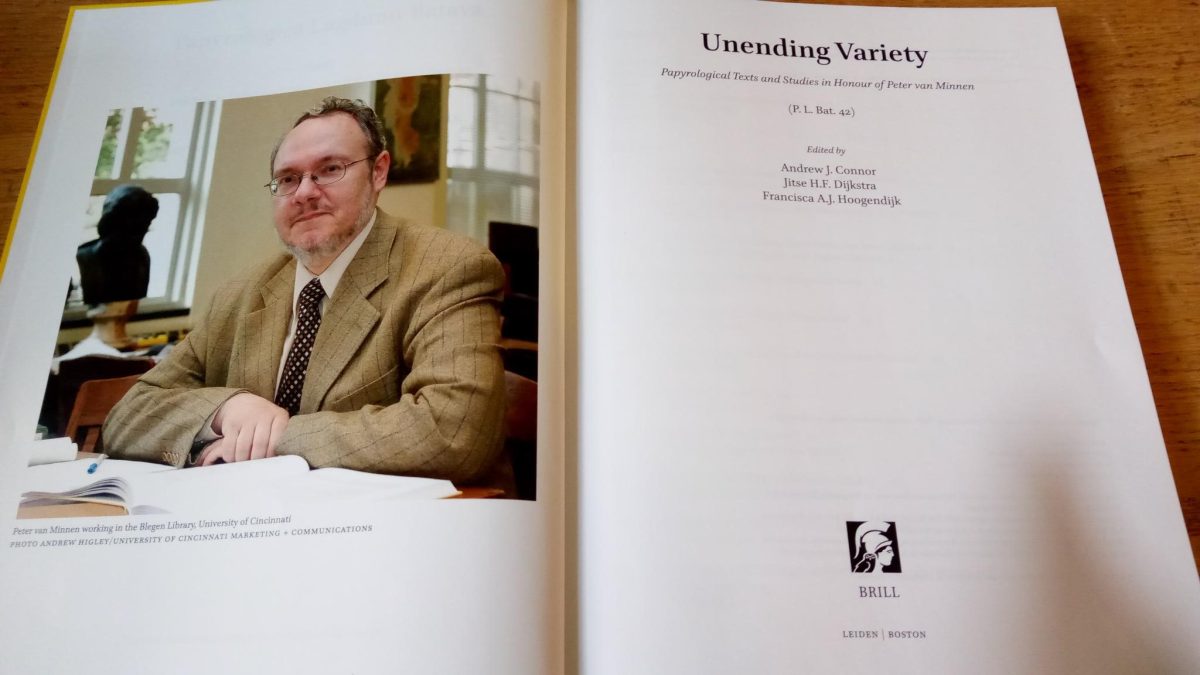
The Festschrift in honor of Peter van Minnen, Unending Variety: Papyrological Texts and Studies in Honour of Peter van Minnen (Papyrologica Lugduno-Batava vol. 42, Leiden; Boston: Brill), and a photo of the honoree taken in the Burnam Classics Library’s main reading room.
A select van Minnen bibliography with call numbers in the Classics Library featured in the exhibition
Claytor, W. Graham and Van Minnen, Peter. “An antichretic loan from early Roman Alexandria.” Zeitschrift für Papyrologie und Epigraphik, no. 217, 2021, pp. 158-164.
CLASS Journals PA3339 .Z4
van Minnen, Peter. “A poll-tax receipt from Hermopolis.” Archiv für Papyrusforschung und Verwandte Gebiete, vol. 66, no. 1, 2020, pp. 83-87.
CLASS Journals PA3339 .A6
van Minnen, Peter. “P. Oxy. 8.1114, P. NYU 2.2.” The Bulletin of the American Society of Papyrologists, vol. 57, 2020, pp. 388.
CLASS Journals AS36.A55 .A2
van Minnen, Peter. “A new palmomantic text.” Archiv für Papyrusforschung und Verwandte Gebiete, vol. 62, no. 1, 2016, pp. 57-66.
CLASS Journals PA3339 .A6
van Minnen, Peter. “A receipt for tax arrears from Hermopolis.” Tyche, vol. 31, 2016, pp. 201-203.
CLASS Journals PA3339 .T92
van Minnen, Peter. “An antichretic loan from early Roman Alexandria revisited (BGU IV 1053).” Zeitschrift für Papyrologie und Epigraphik, no. 199, 2016, pp. 144-154.
CLASS Journals PA3339 .Z4
van Minnen, Peter. “Three edicts of Caracalla?: A new reading of P. Giss. 40.” Chiron, vol. 46, 2016, pp. 205-221.
CLASS Journals D51 .C35
van Minnen, Peter. “From Posidippus to Palladas: What have literary papyri done for us?” The Journal of Juristic Papyrology, vol. 43, 2013, pp. 243-261.
CLASS Journals PA3339 .J6
van Minnen, Peter. “Hermopolis and its papyri.” 100 anni di istituzioni fiorentine per la papirologia: 1908, Società Italiana per la ricerca dei papiri, 1928, Istituto Papirologico «G. Vitelli»: Atti del convegno internazionale di studi, Firenze, 12-13 giugno 2008. Eds. Bastianini, Guido, Stroppa, Marco and Casanova, Angelo. Studi e Testi di Papirologia / Istituto Papirologico G. Vitelli. N. S.; 11. Firenze: Istituto Papirologico G. Vitelli, 2009, pp. 1-15.
CLASS Journals Z110.P36 A23 2009
van Minnen, Peter. “The millenium of papyrology (2001-)?” Akten des 23. Internationalen Papyrologenkongresses: Wien, 22.-28. Juli 2001. Ed. Palme, Bernhard. Papyrologica Vindobonensia; 1. Wien: Verlag der Österreichischen Akademie der Wissenschaften, 2007, pp. 703-714.
CLASS Journals PA3339. P36 Bd.1
van Minnen, Peter. “The other cities in later Roman Egypt.” Egypt in the Byzantine world, 300-700. Ed. Bagnall, Roger S. Cambridge; New York: Cambridge University Press, 2007, pp. 207-225.
CLASS Journals DT60.E2995 2007
van Minnen, Peter. “The changing world of the cities of later Roman Egypt.” Die Stadt in der Spätantike – Niedergang oder Wandel ?: Akten des internationalen Kolloquiums in München am 30. und 31. Mai 2003. Eds. Krause, Jens-Uwe and Witschel, Christian. Historia. Einzelschriften; 190. Stuttgart: Steiner, 2006, pp. 153-179.
CLASS Journals D53.A2 H5 Hft. 190
van Minnen, Peter. “Αἱ ἀπο γυμνασίου: « Greek » women and the Greek « elite » in the metropoleis of Roman Egypt.” Le rôle et le statut de la femme en Égypte hellénistique, romaine et byzantine: actes du colloque international, Bruxelles-Leuven, 27-29 novembre 1997. Eds. Melaerts, Henri and Mooren, Léon. Studia Hellenistica; 37. Leuven: Peeters, 2002, pp. 337-353.
CLASS Journals HQ1137. E3 R65 2002
van Minnen, Peter. “Dietary Hellenization or ecological transformation?: Beer, wine and oil in later Roman Egypt.” Atti del XXII congresso internazionale di papirologia: Firenze, 23-29 agosto 1998. Ed. Andorlini, Isabella. Firenze: Istituto Papirologico G. Vitelli, 2001. pp 1265-1280.
EpiPap PA3339. I5 1998
van Minnen, Peter. “Further thoughts on the Cleopatra papyrus.” Archiv für Papyrusforschung und Verwandte Gebiete, vol. 47, no. 1, 2001, pp. 74-80.
CLASS Journals PA3339 .A6
van Minnen, Peter. “An official act of Cleopatra: (with a subscription in her own hand).” Ancient Society, vol. 30, 2000, pp. 29-34.
CLASS Journals D51 .A57
van Minnen, Peter. “Boorish or bookish?: Literature in Egyptian villages in the Fayum in the Graeco-Roman period.” The Journal of Juristic Papyrology, vol. 28, 1998, pp. 99-184.
CLASS Journals PA3339 .J6
van Minnen, Peter. “The Century of Papyrology (1892-1992).” The Bulletin of the American Society of Papyrologists, vol. 30, no. 1/2, 1993, pp. 5–18.
CLASS Journals AS36.A55 .A2
van Minnen, Peter. “A Dutch opinion of Amedeo Peyron.” Aegyptus, vol. 76, no. 1-2, 1996, pp. 157-165.
CLASS Journals PA3339 .A4
Gagos, Traianos and Peter van Minnen. Settling a dispute: Toward a legal anthropology of late antique Egypt. Ann Arbor: University of Michigan Press, 1994.
CLASS Stacks KJA670. E3 1994
van Minnen, Peter. “The origin and future of papyrology: From Mommsen and Wilamowitz to the present, from Altertumswissenschaft to Cultural Studies.” Proceedings of the 20th international congress of papyrologists: Copenhagen, 23-29 August, 1992. Ed. Bülow-Jacobsen, Adam. Copenhagen: Museum Tusculanum Press, 1994, pp. 35-41.
EpiPap Oversize PA3342. I5 1992
van Minnen, Peter. “Isocrates and Menander in late antique perspective.” Greek, Roman and Byzantine Studies, vol. 33, 1992, pp. 87-98.
CLASS Journals DE1 .G72
van Minnen, Peter. “Lentils from Pelusium: A note on Vergil’s Georgics I, 228.” Mnemosyne, vol. XLIV, 1991, pp. 167-170.
CLASS Journals PA1 .M6
Hoogendijk, Francisca A. J., Van Minnen, Peter and Clarysse, Willy. Papyri, ostraca, parchments and waxed tablets in the Leiden Papyrological Institute: (P.L. Bat. 25). Papyrologica Lugduno-Batava; 25. Leiden: Brill, 1991.
CLASS Stacks PA3339. P3 v. 25
Clarysse, Willy, Daniel, Robert Walter, Hoogendijk, Francisca A. J. and Van Minnen, Peter. Berichtigungsliste der griechischen Papyrusurkunden aus Ägypten: Konkordanz und Supplement zu Band I-VII : (B. L. Konkordanz). Leuven: Peeters, 1989.
CLASS Stacks PA3315 .E5
